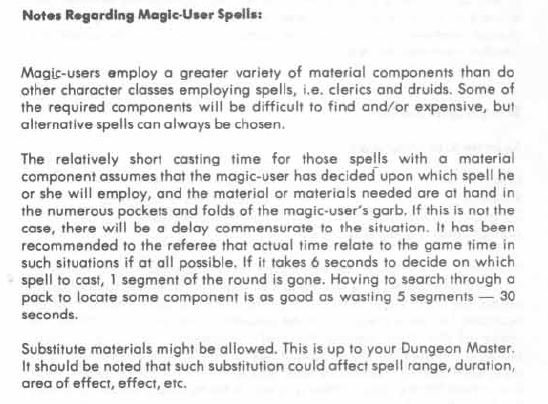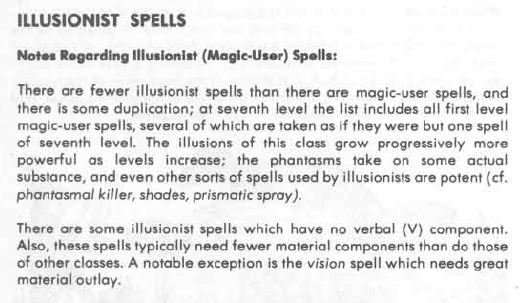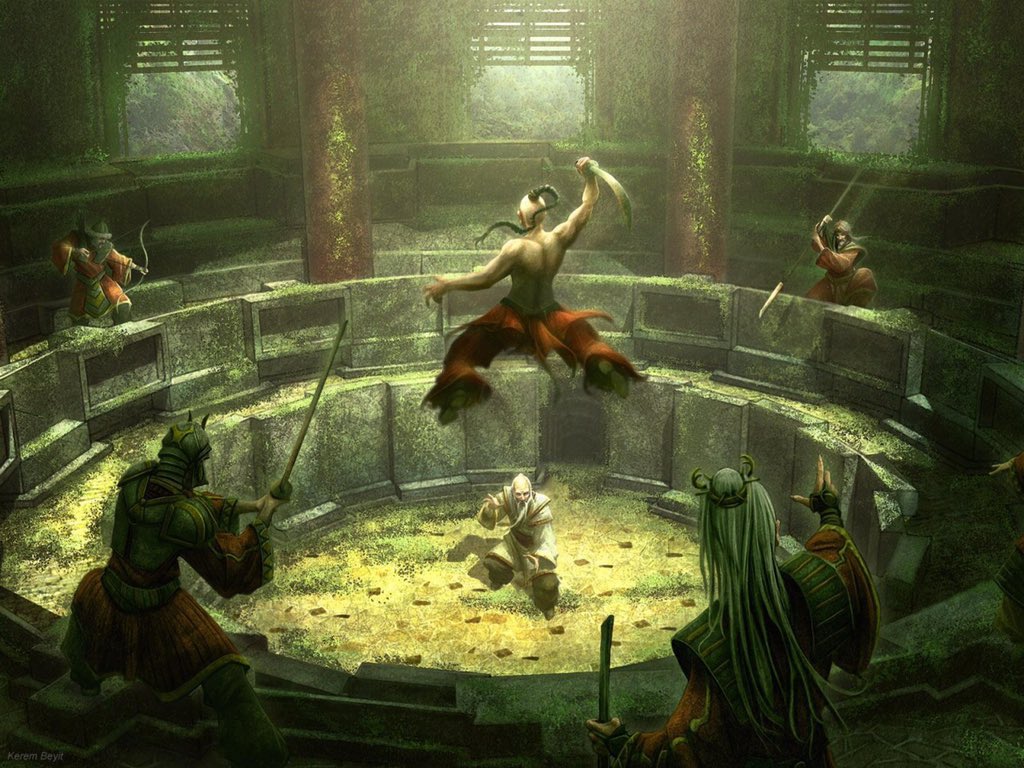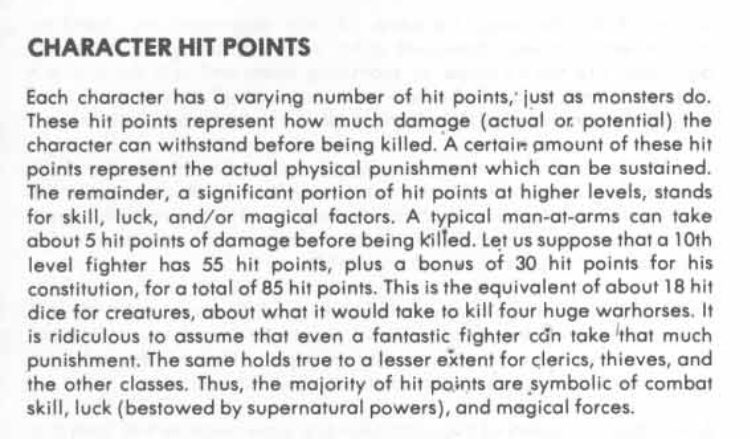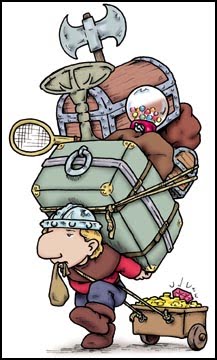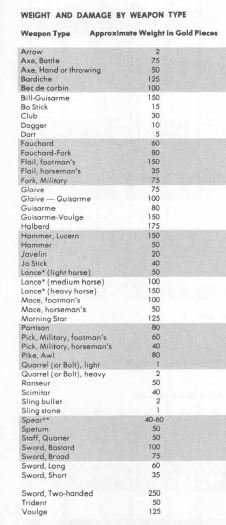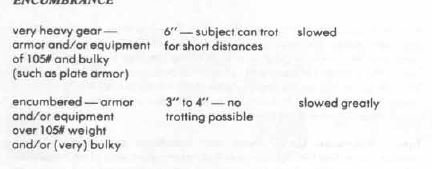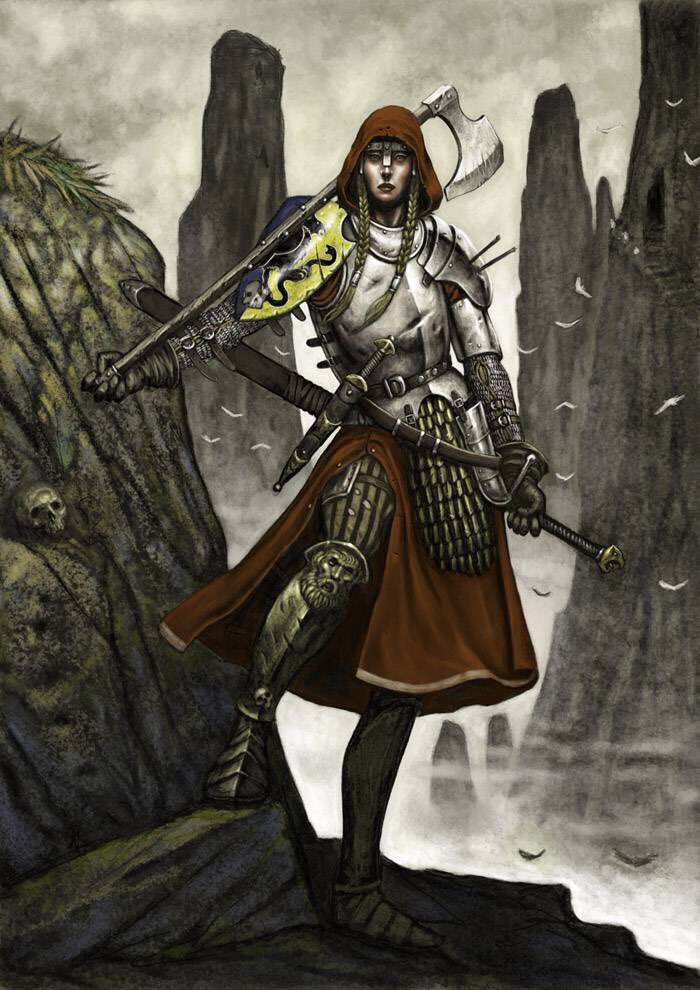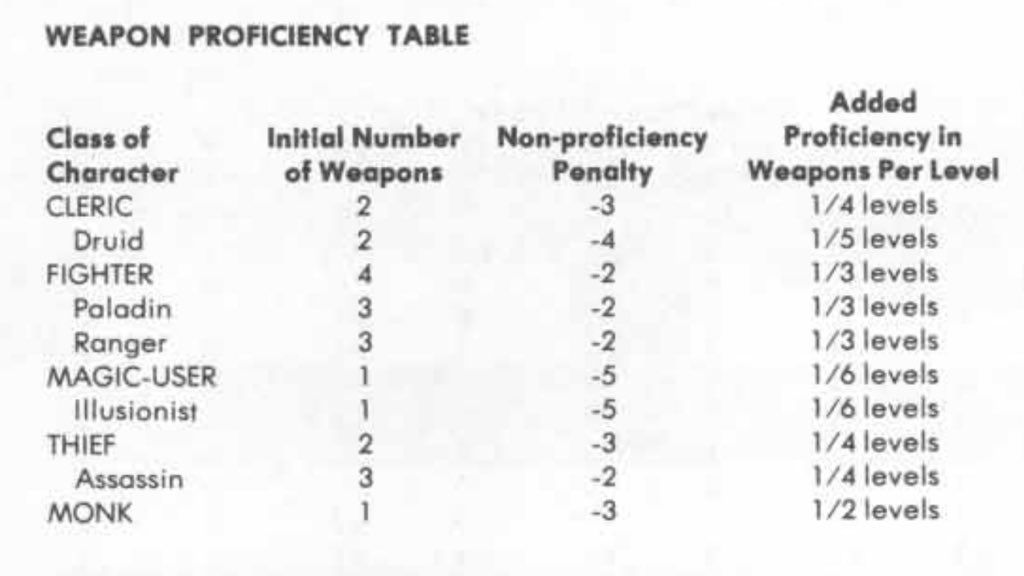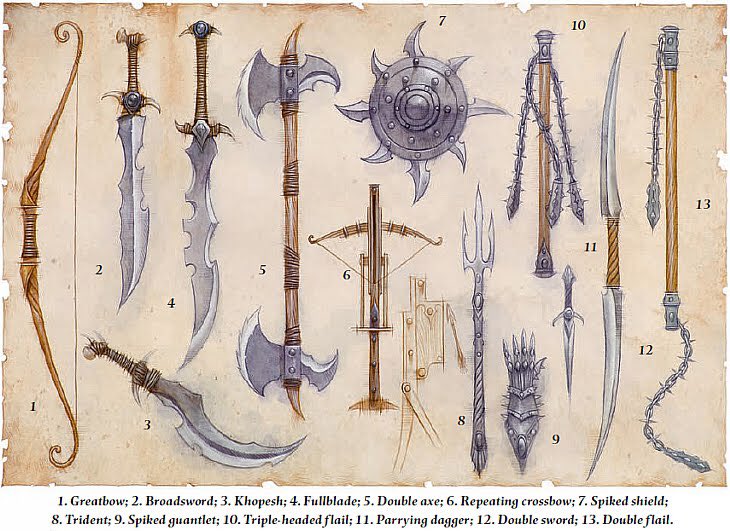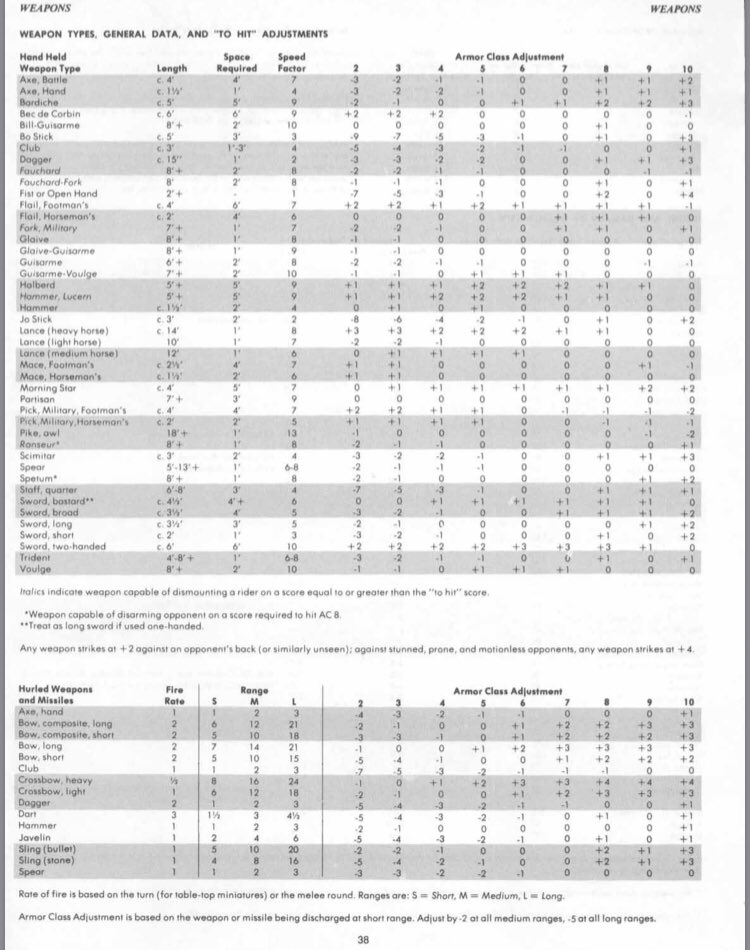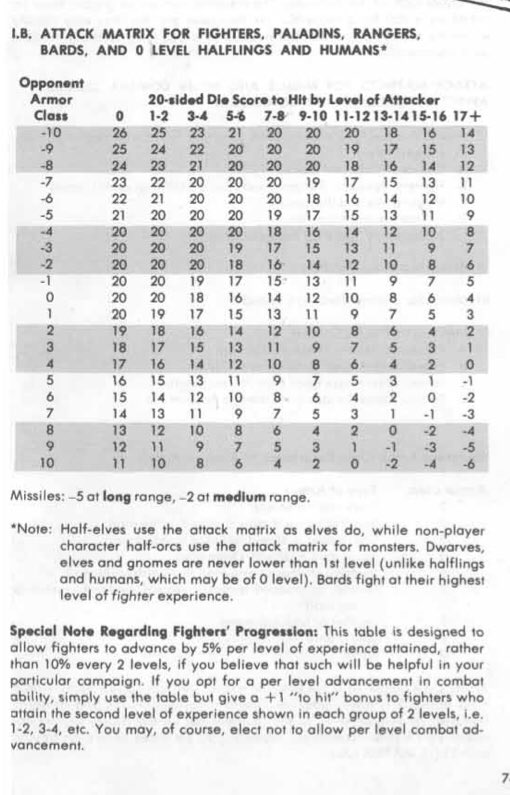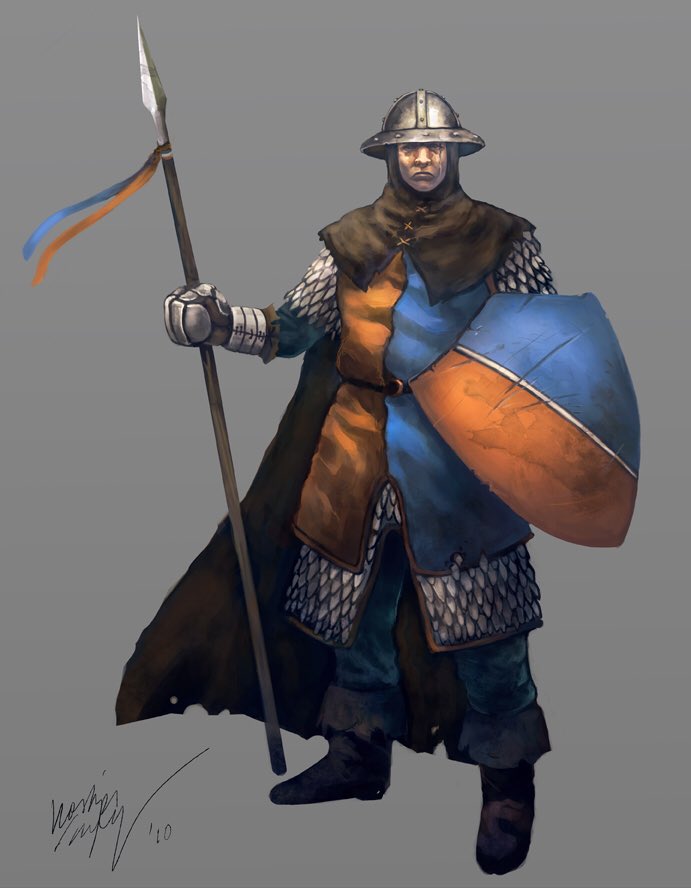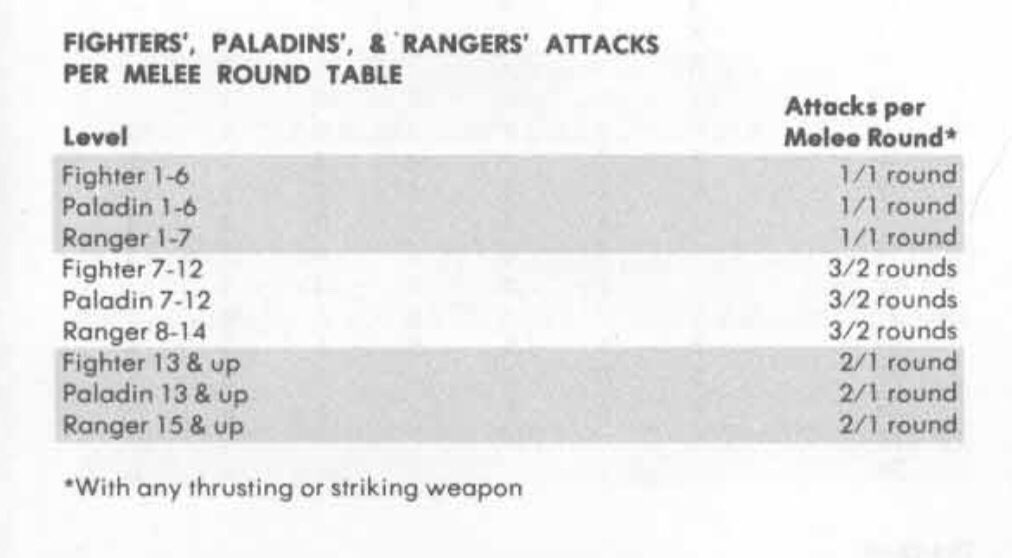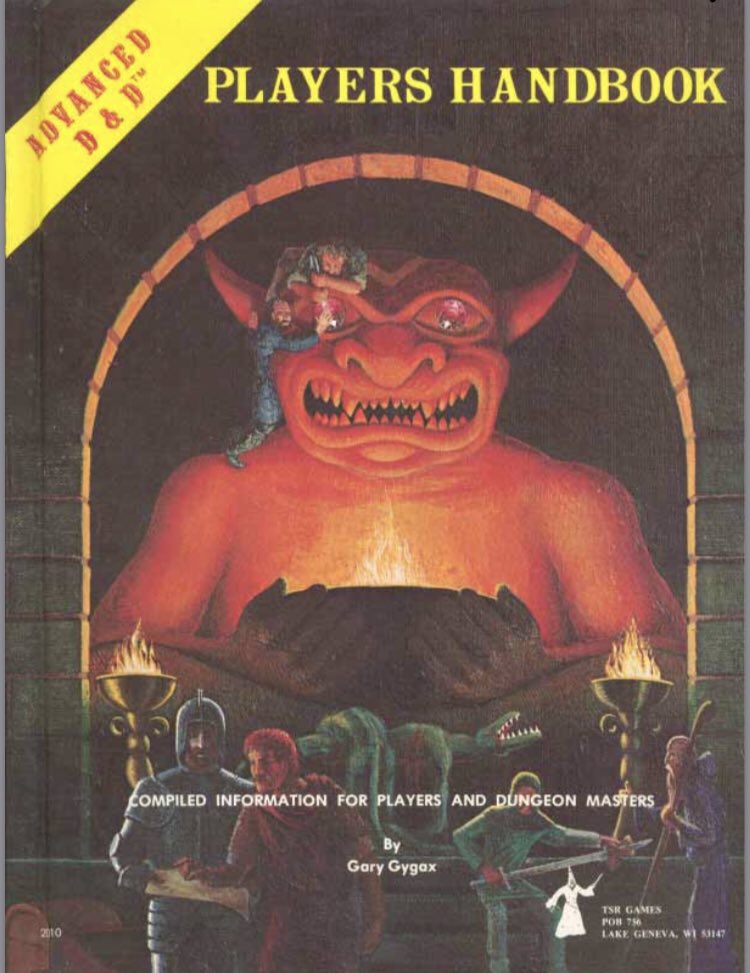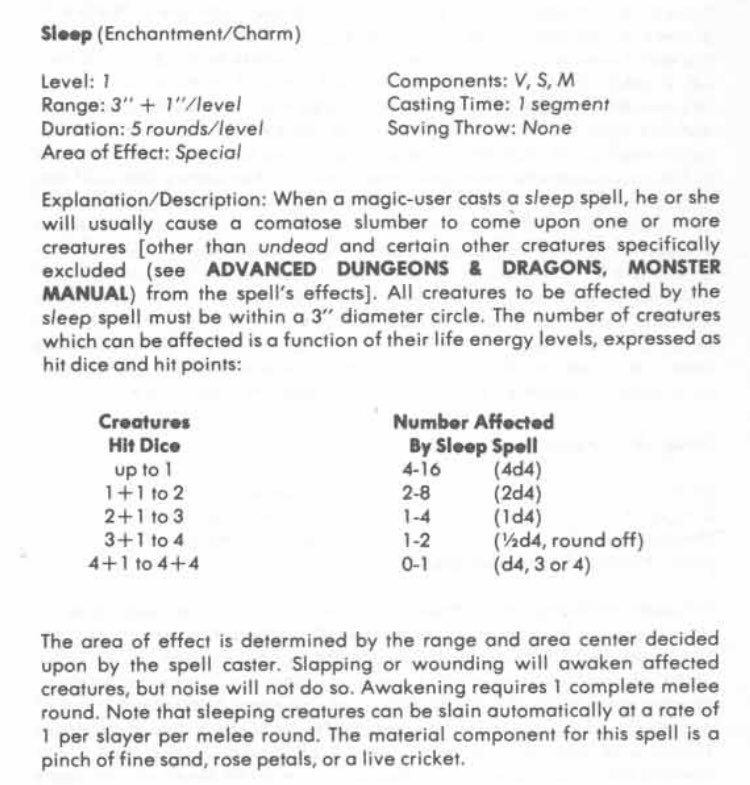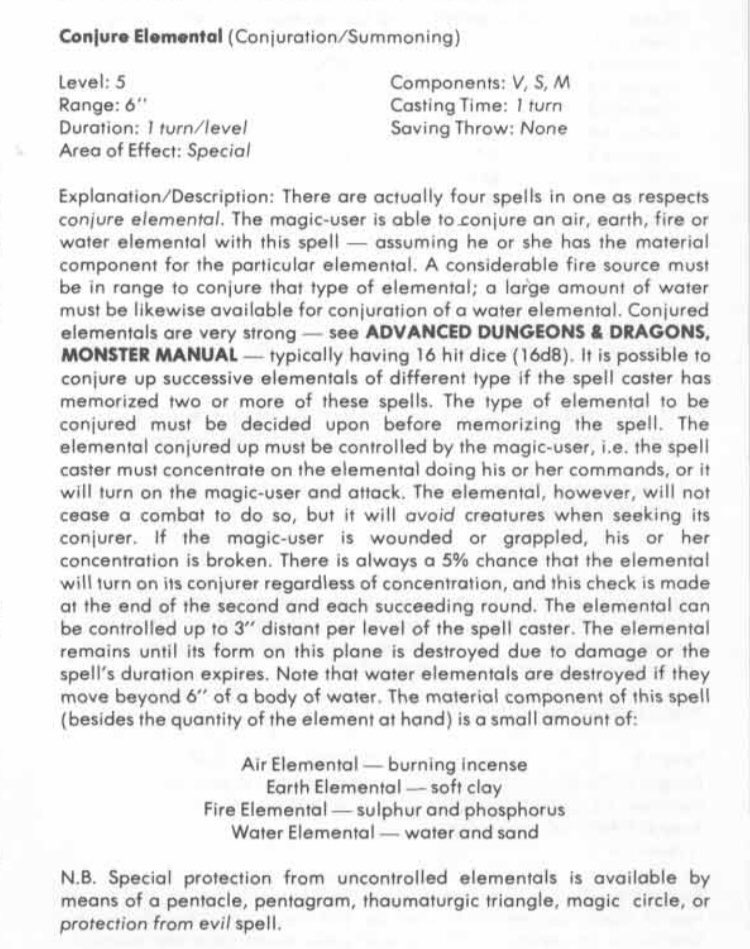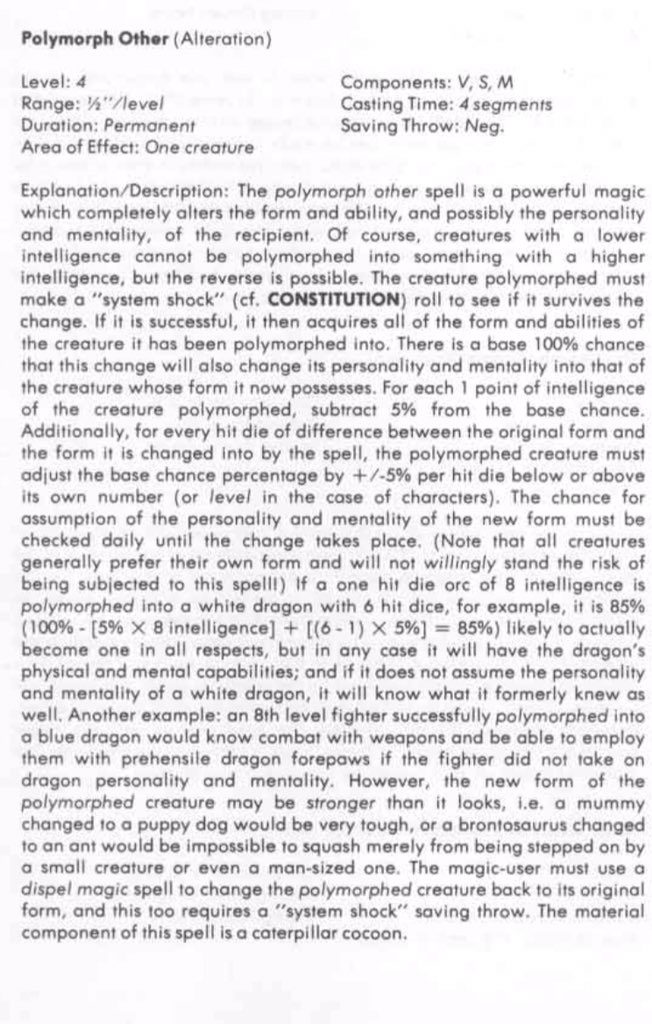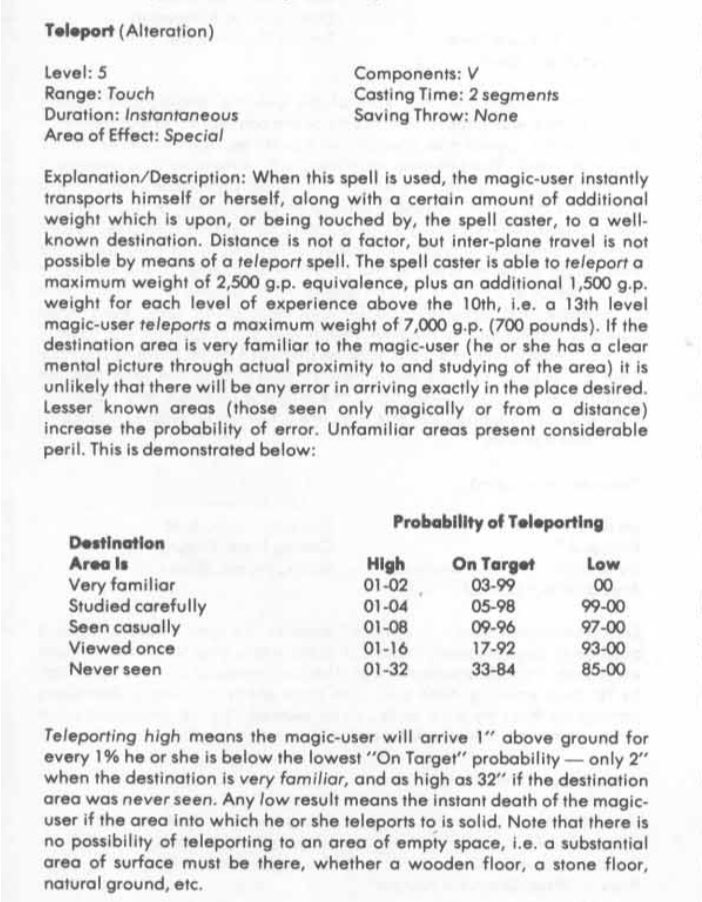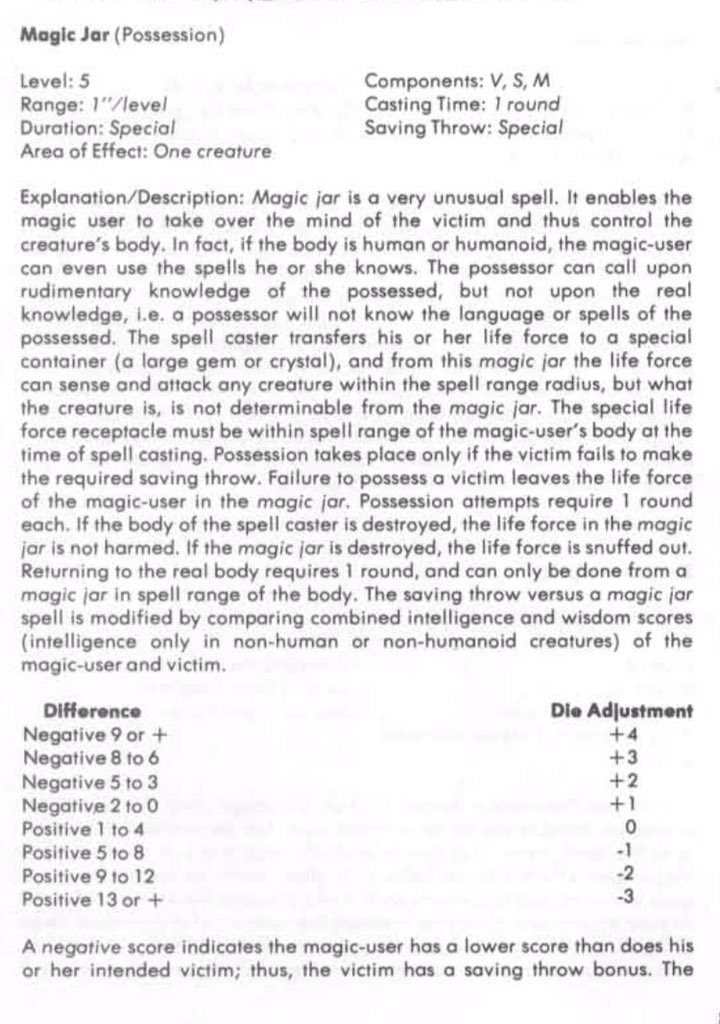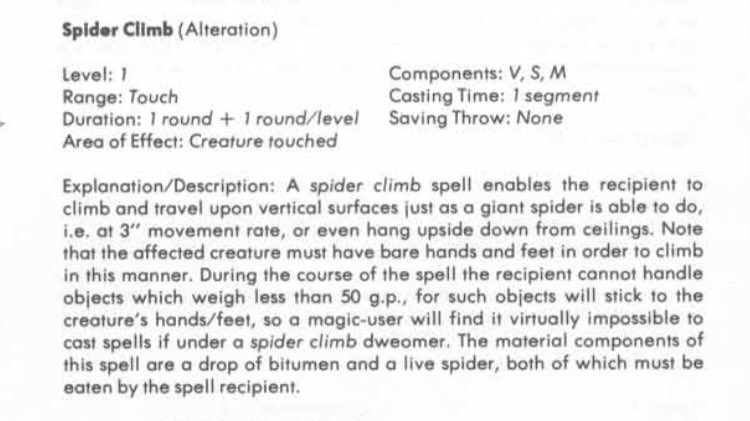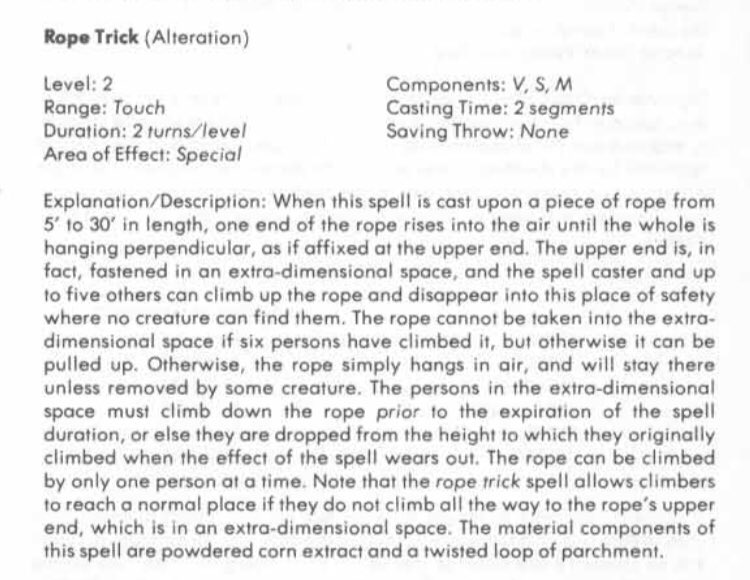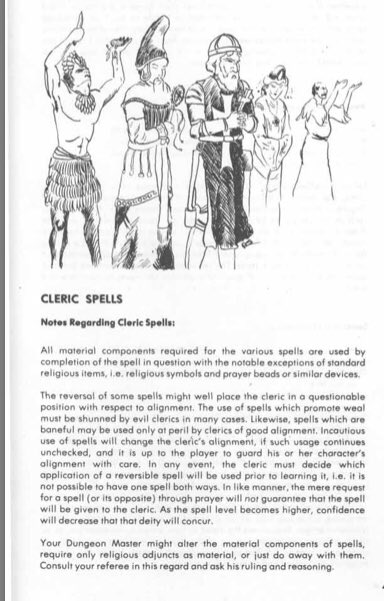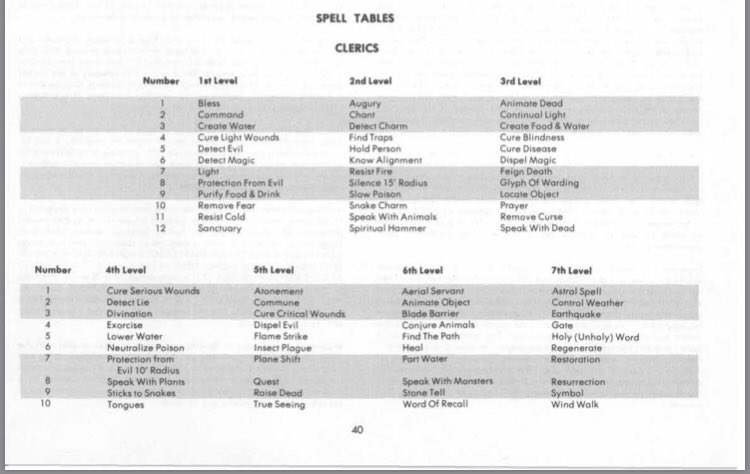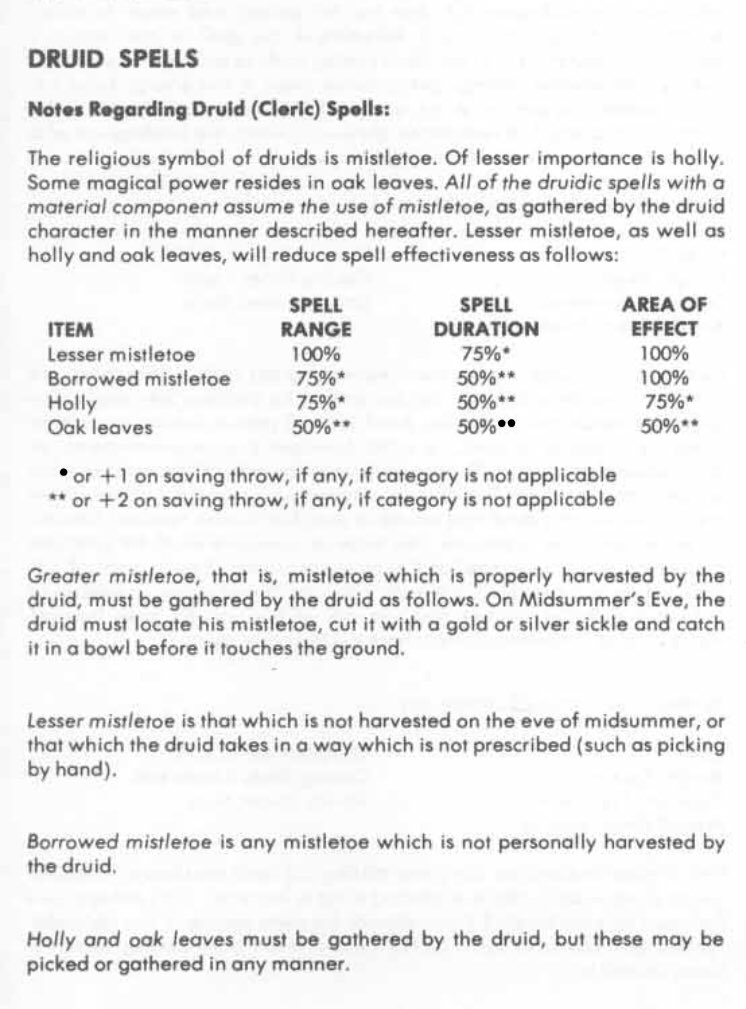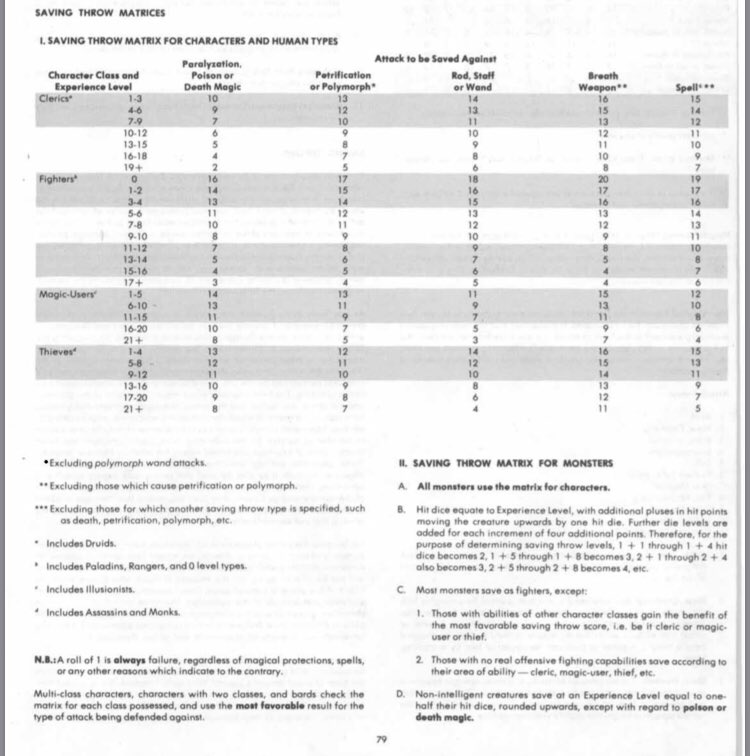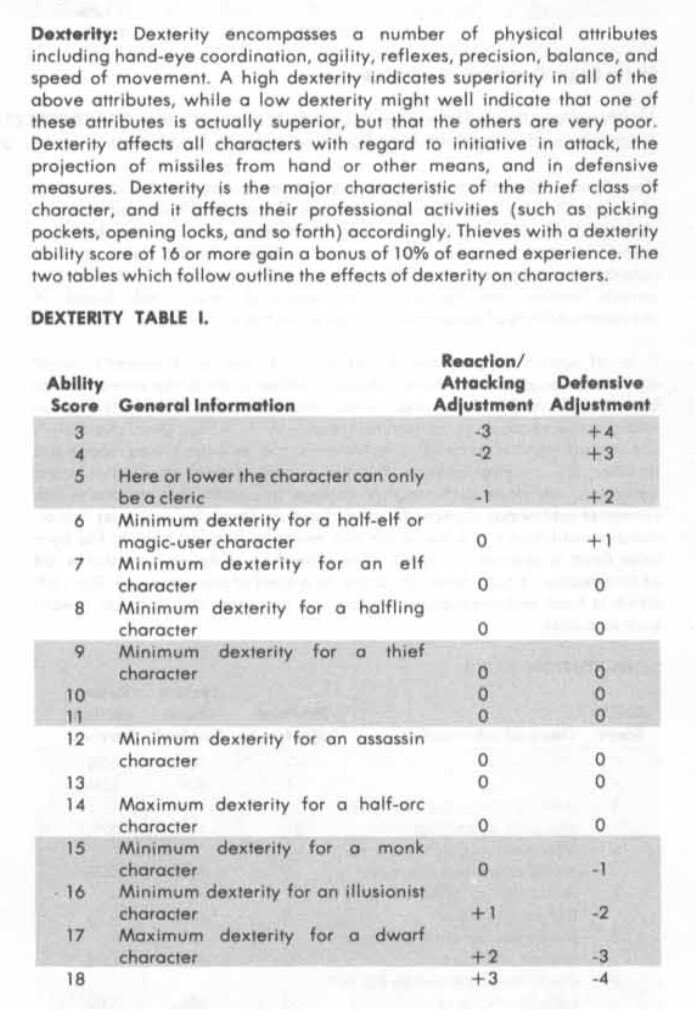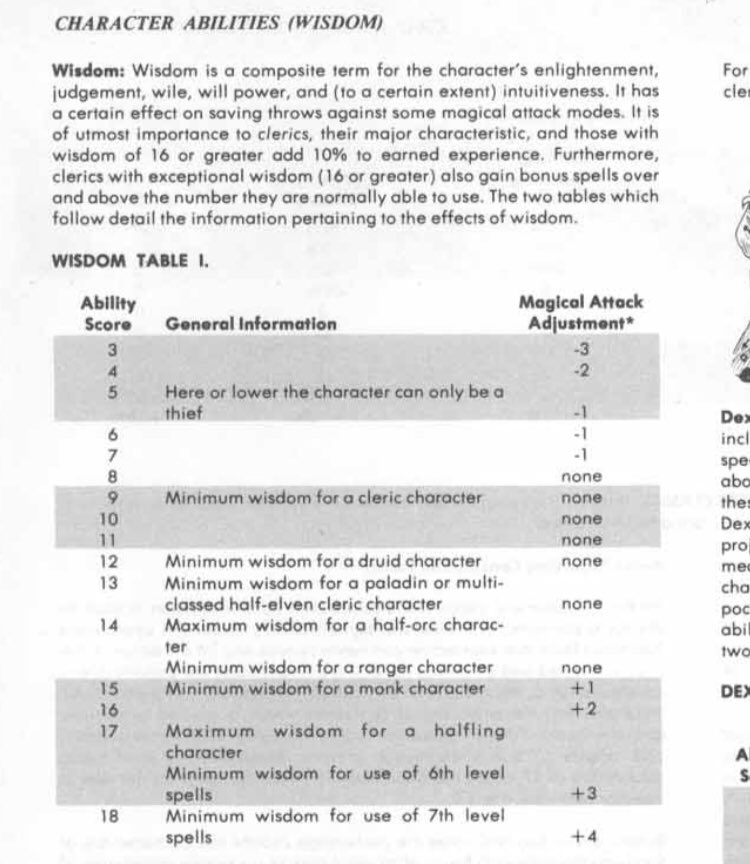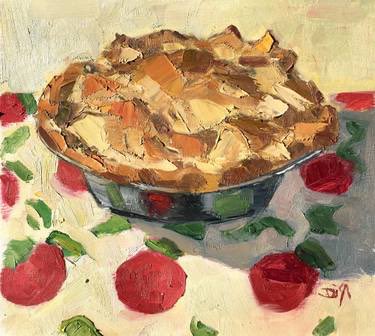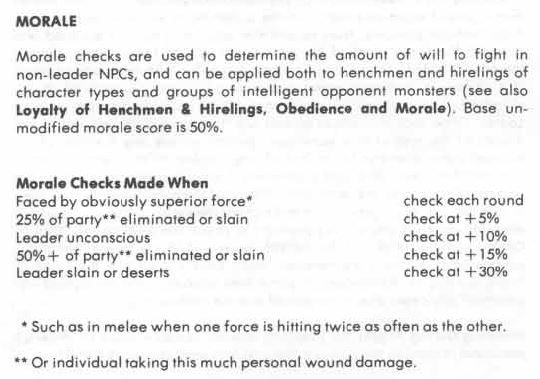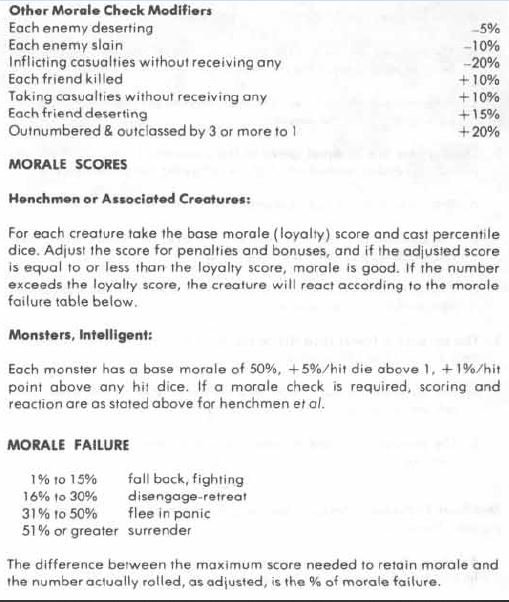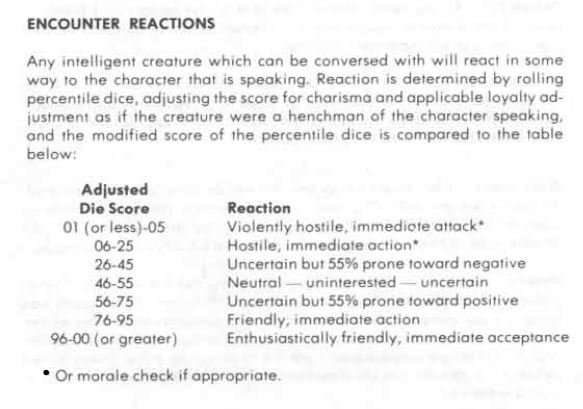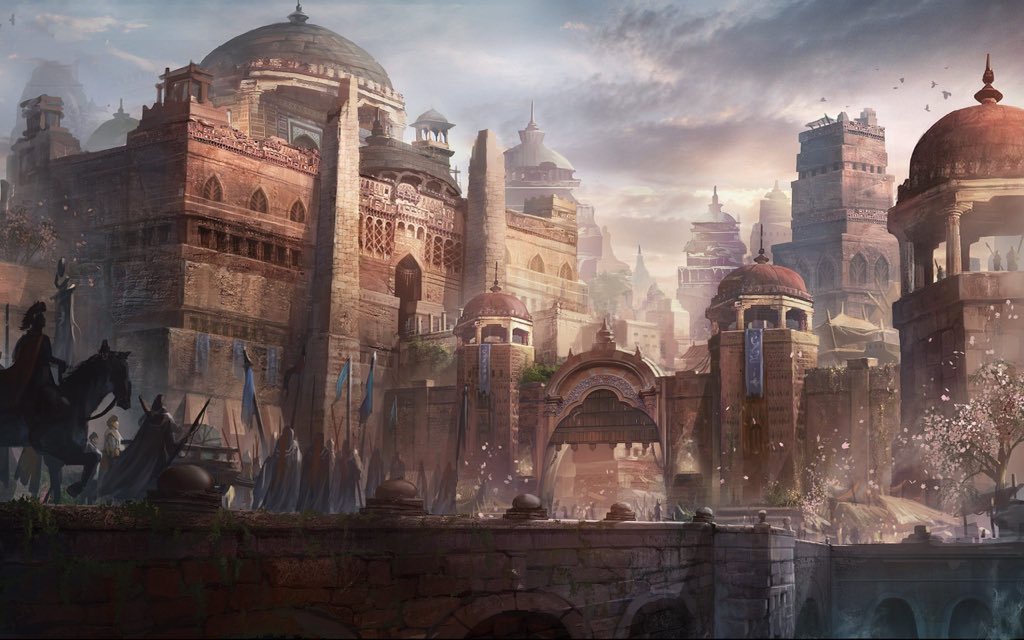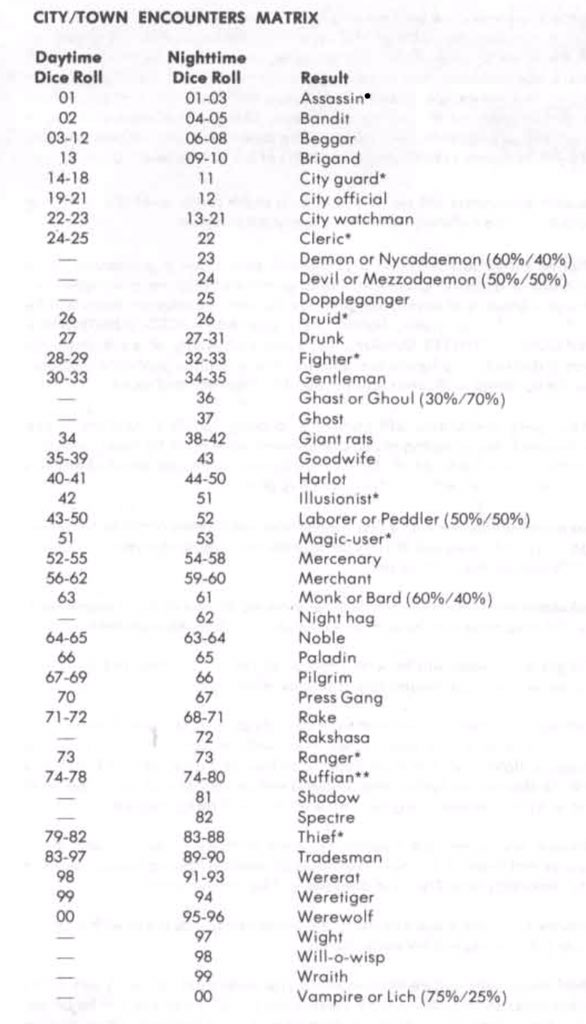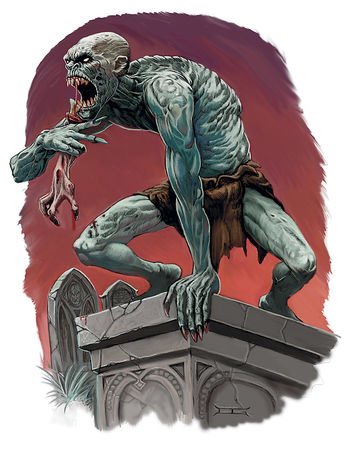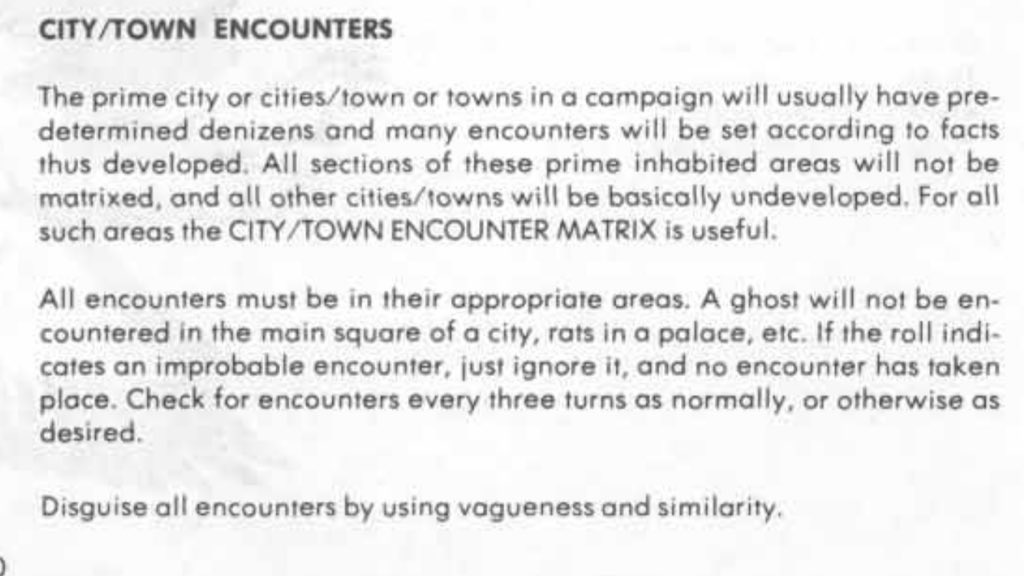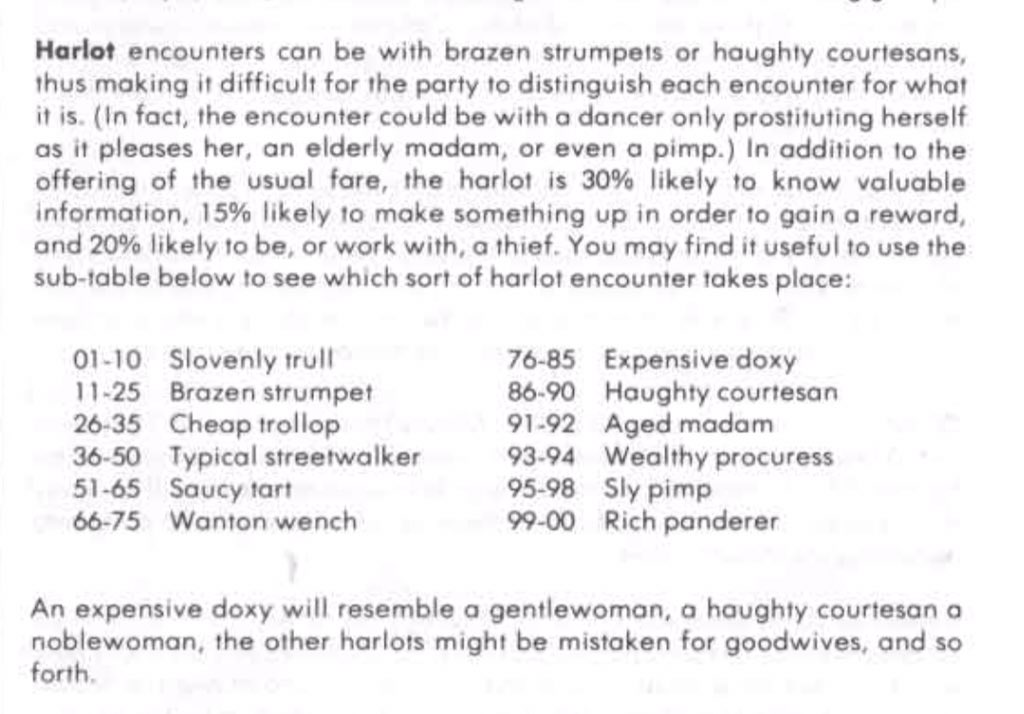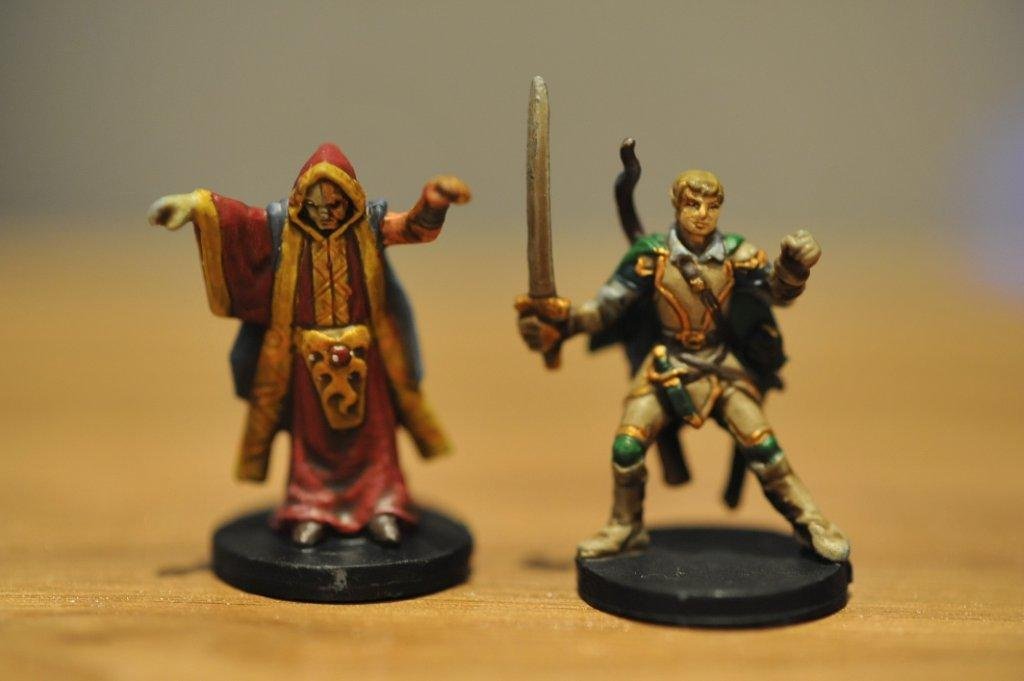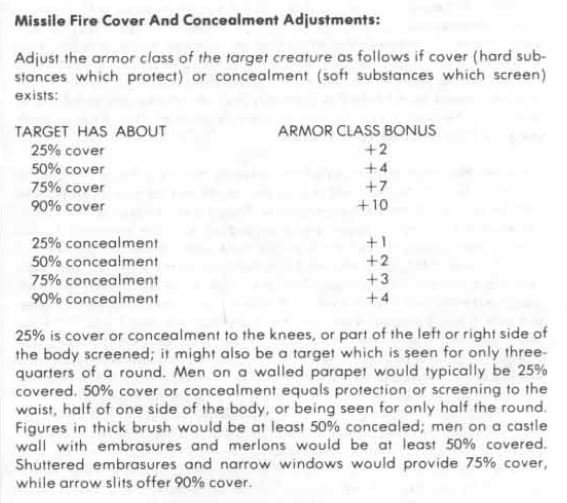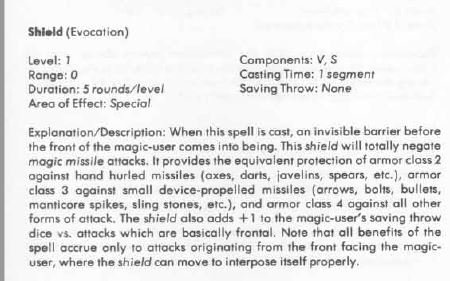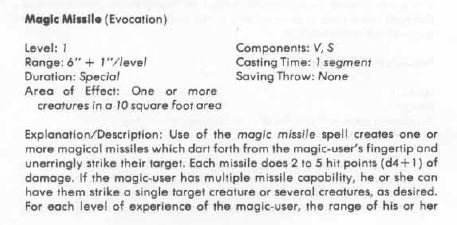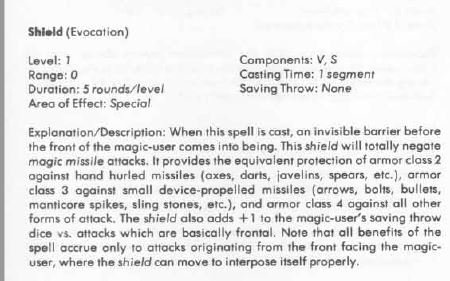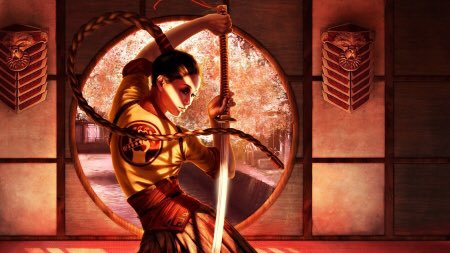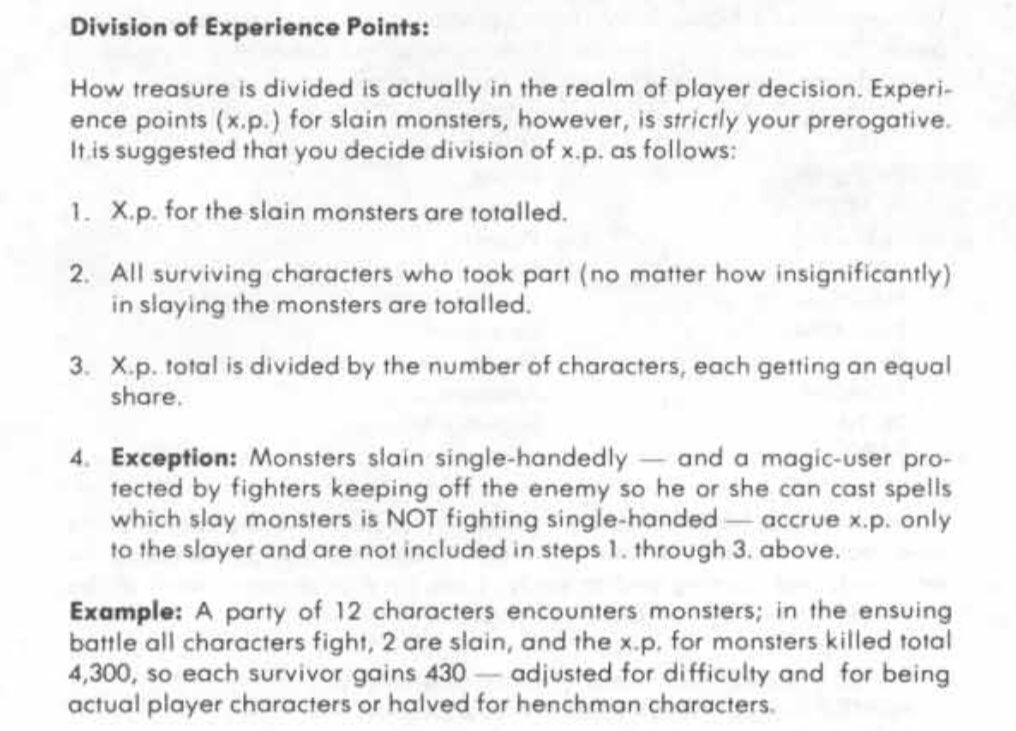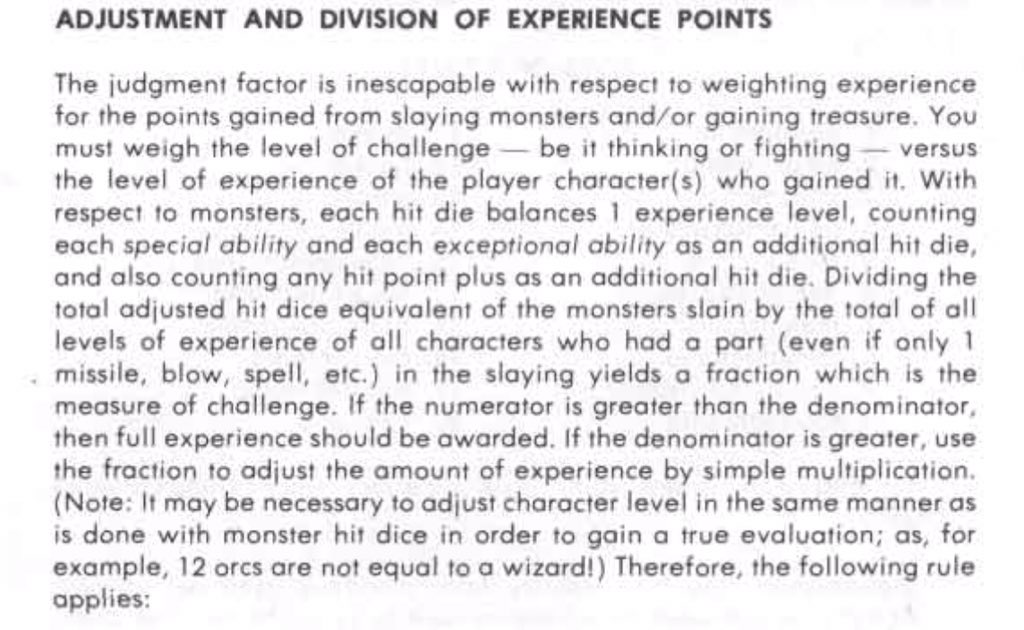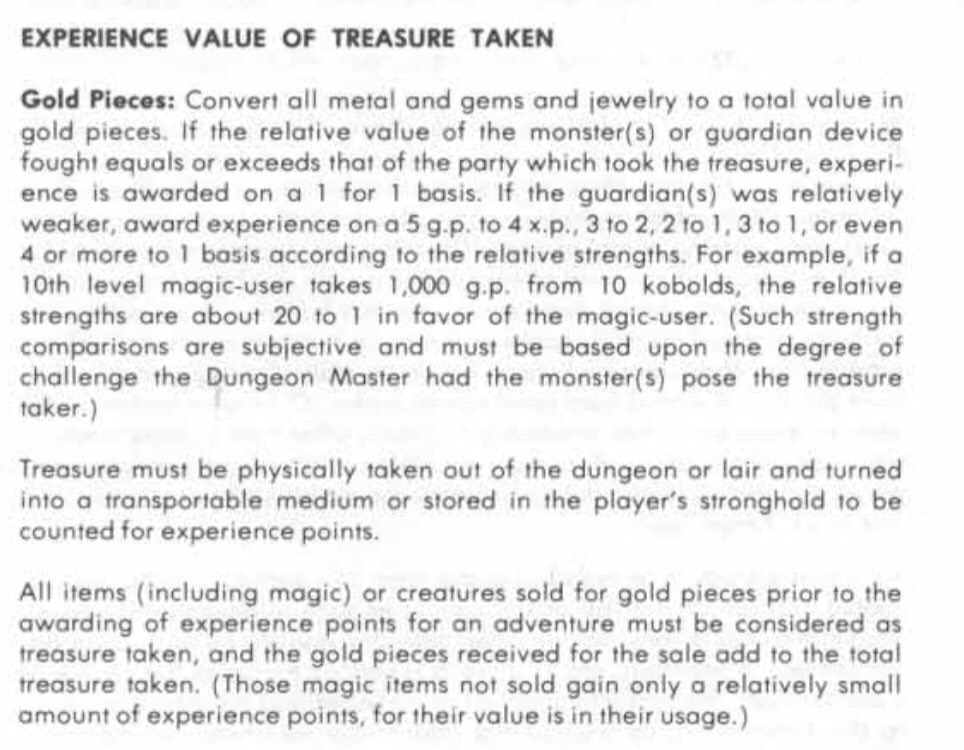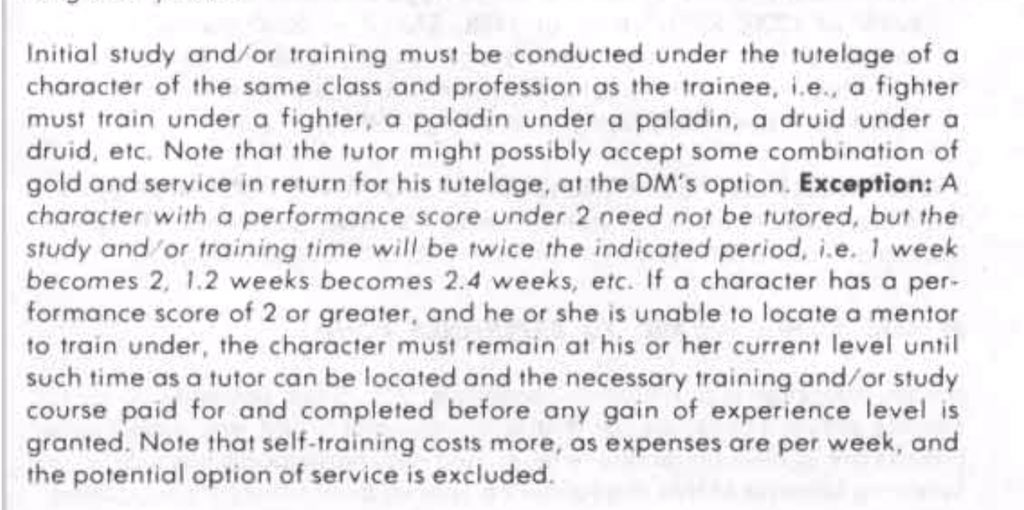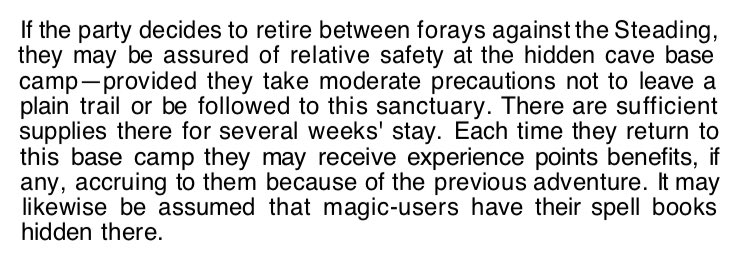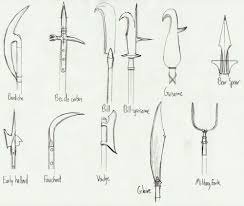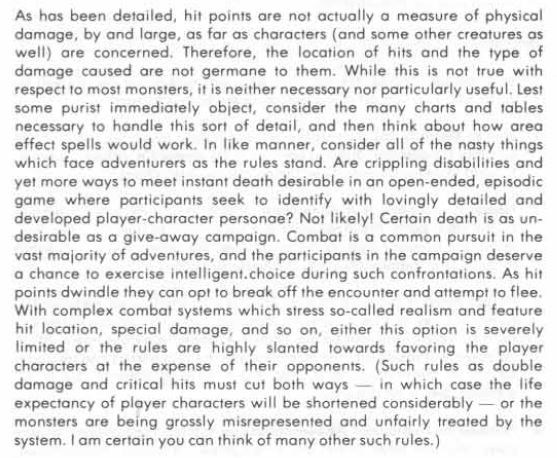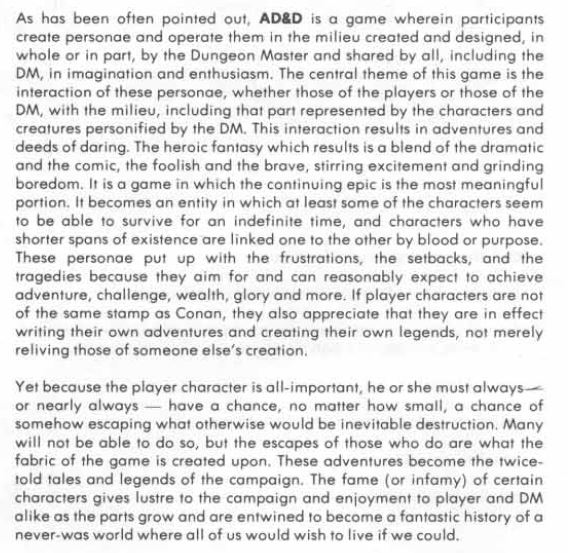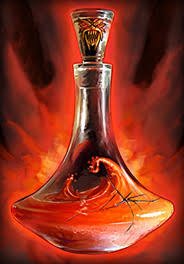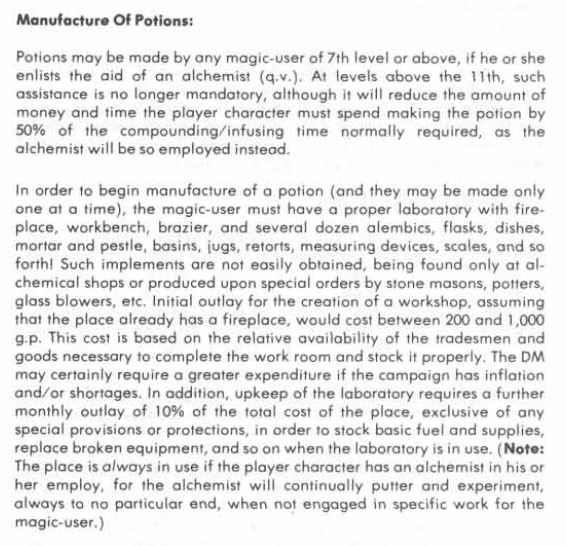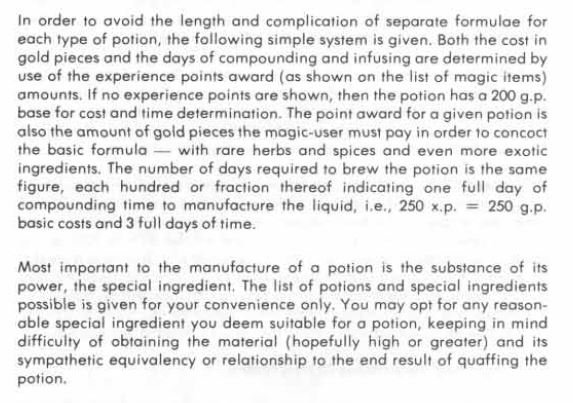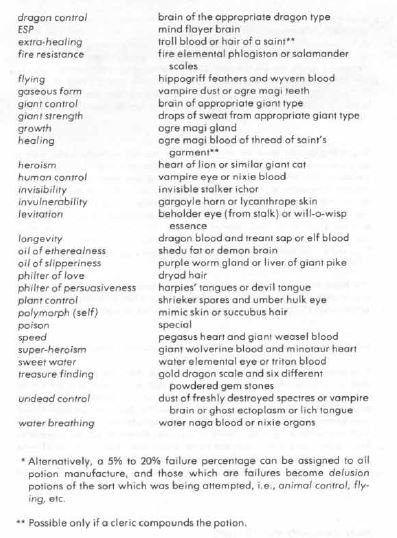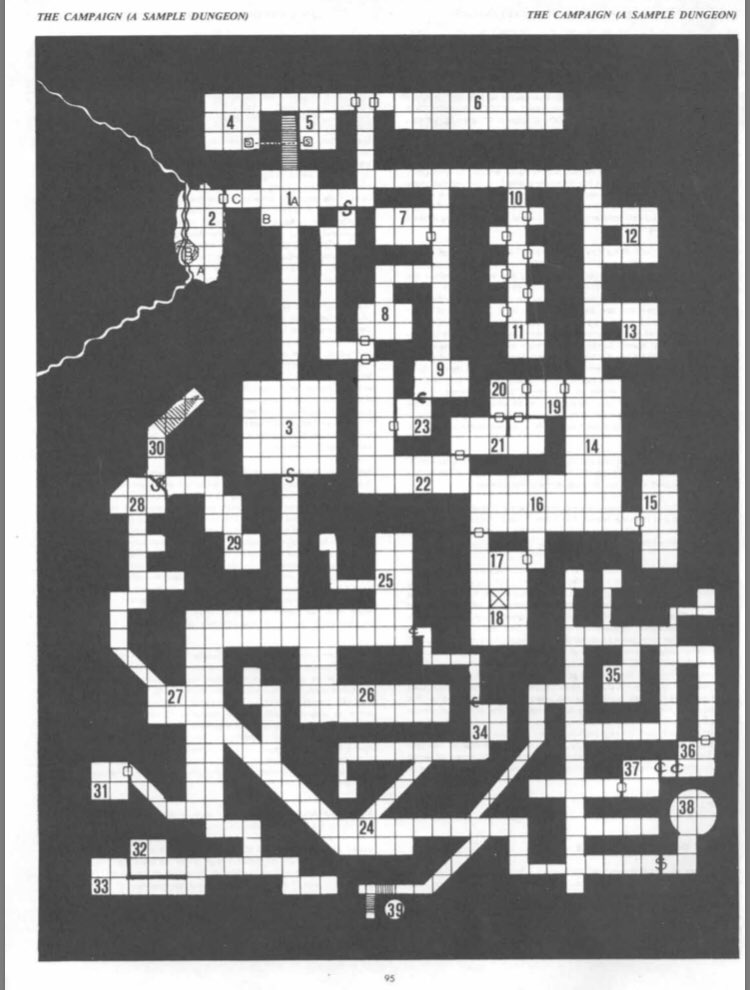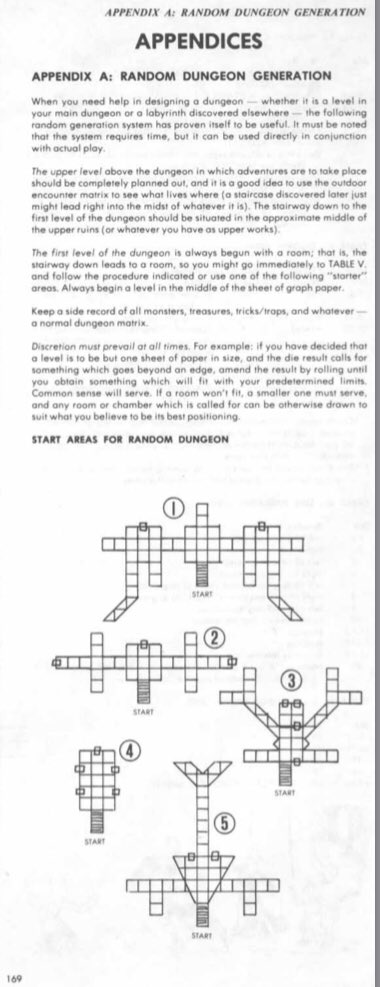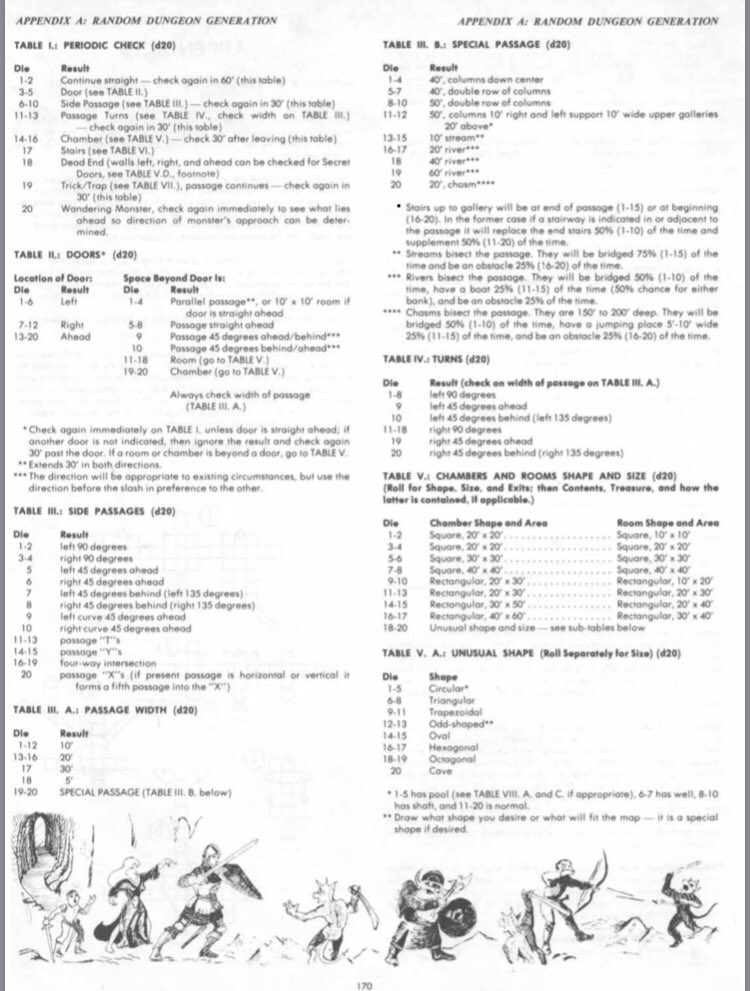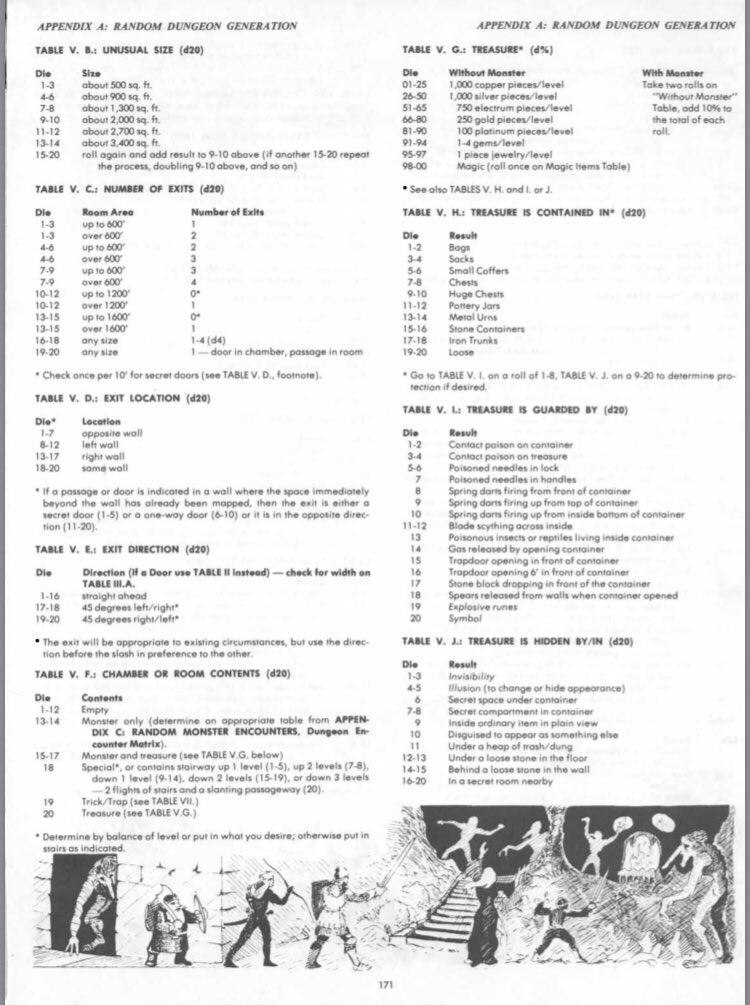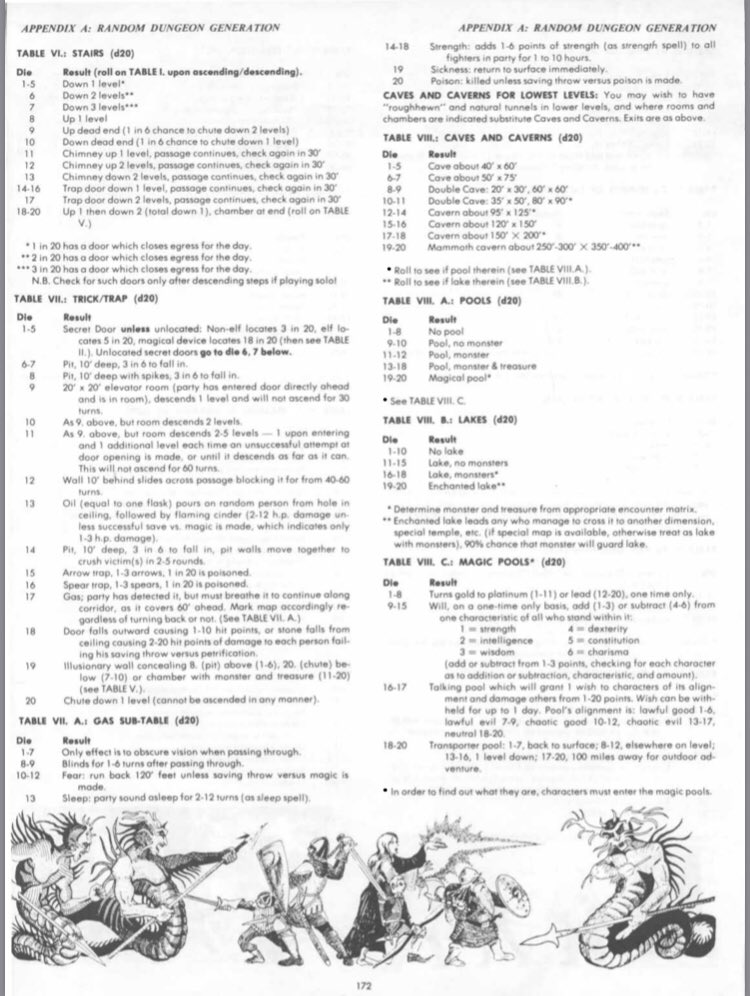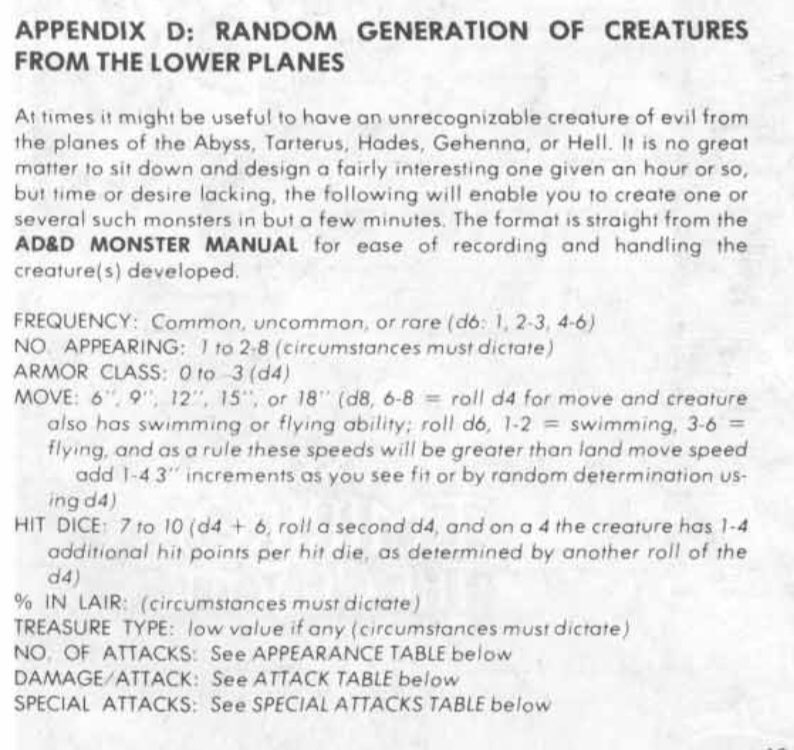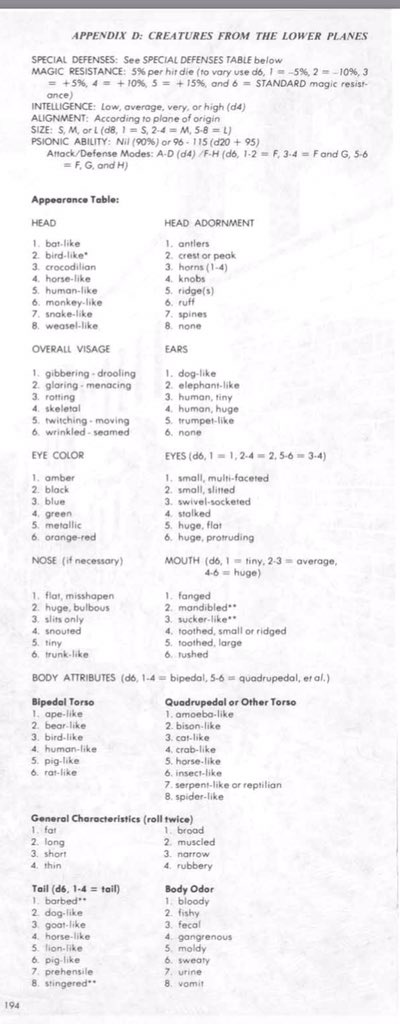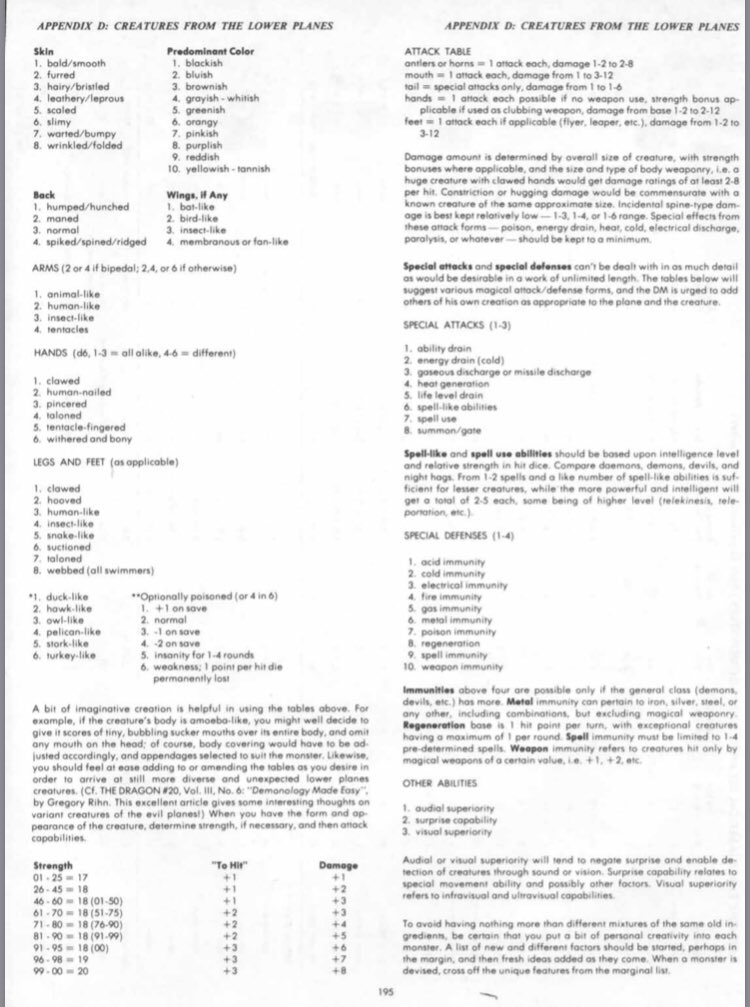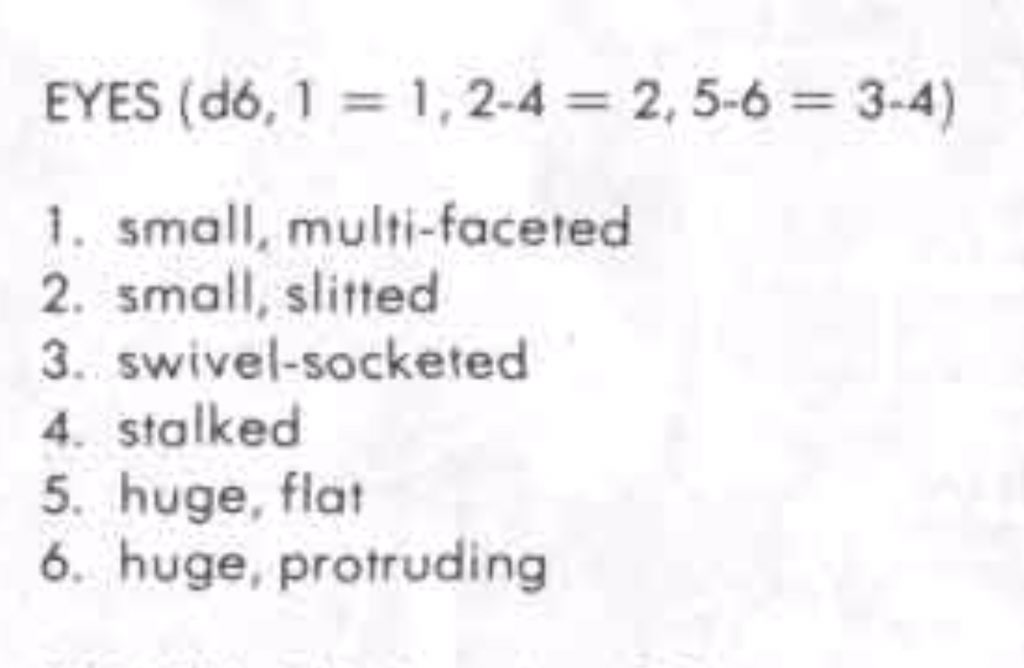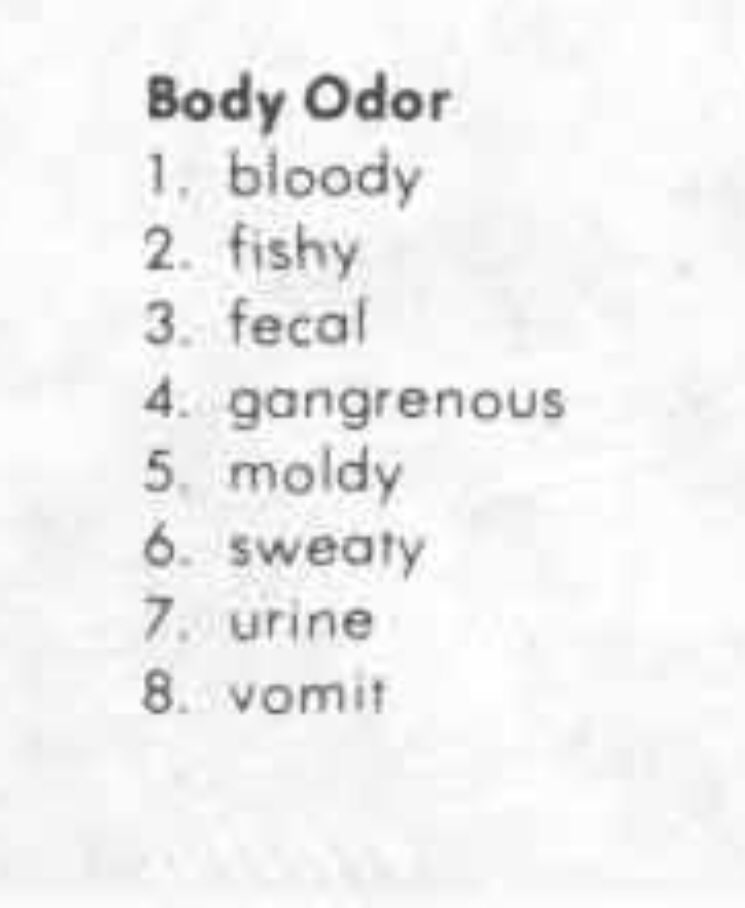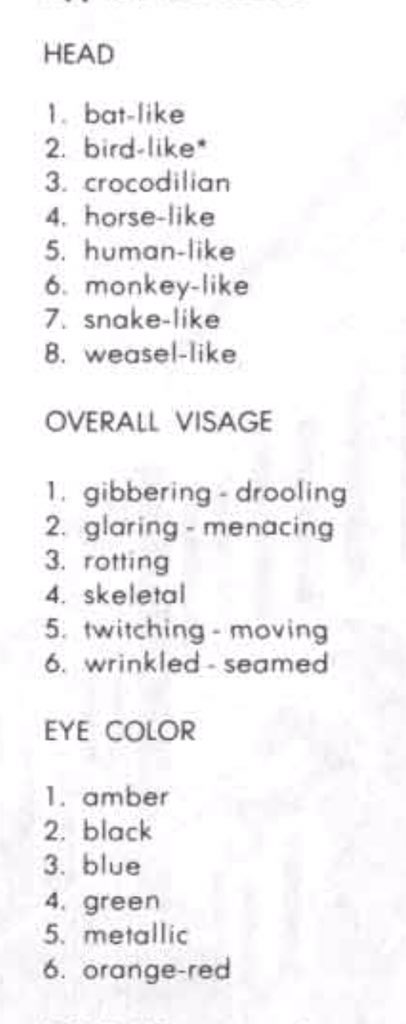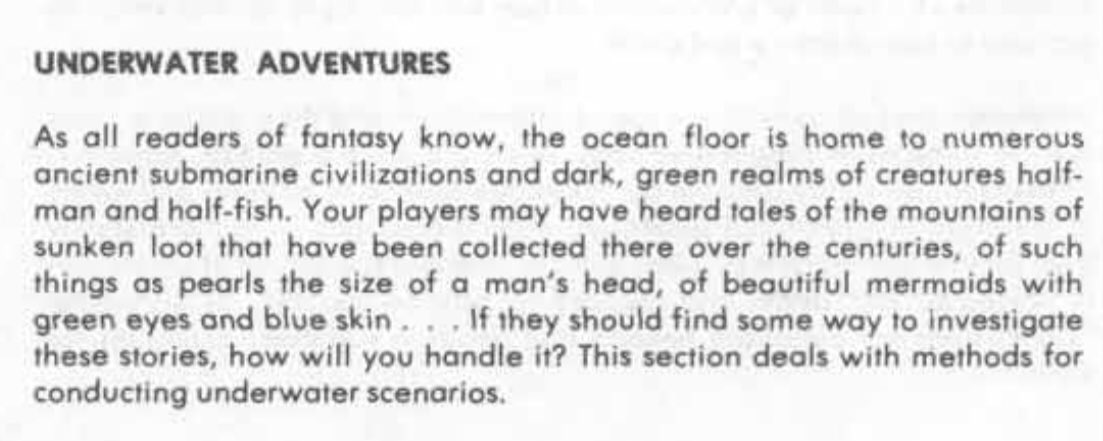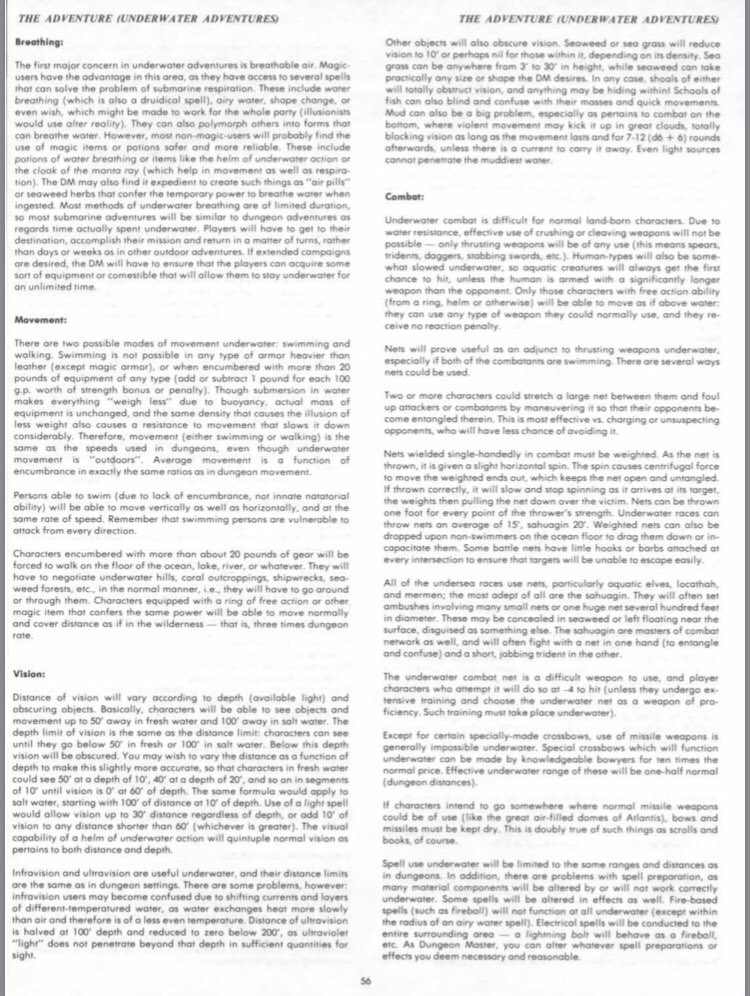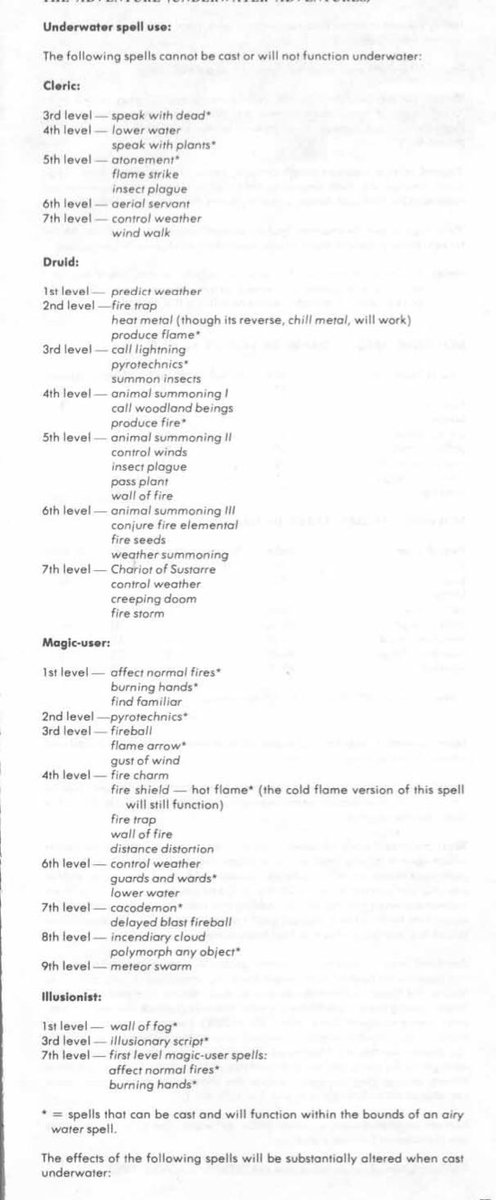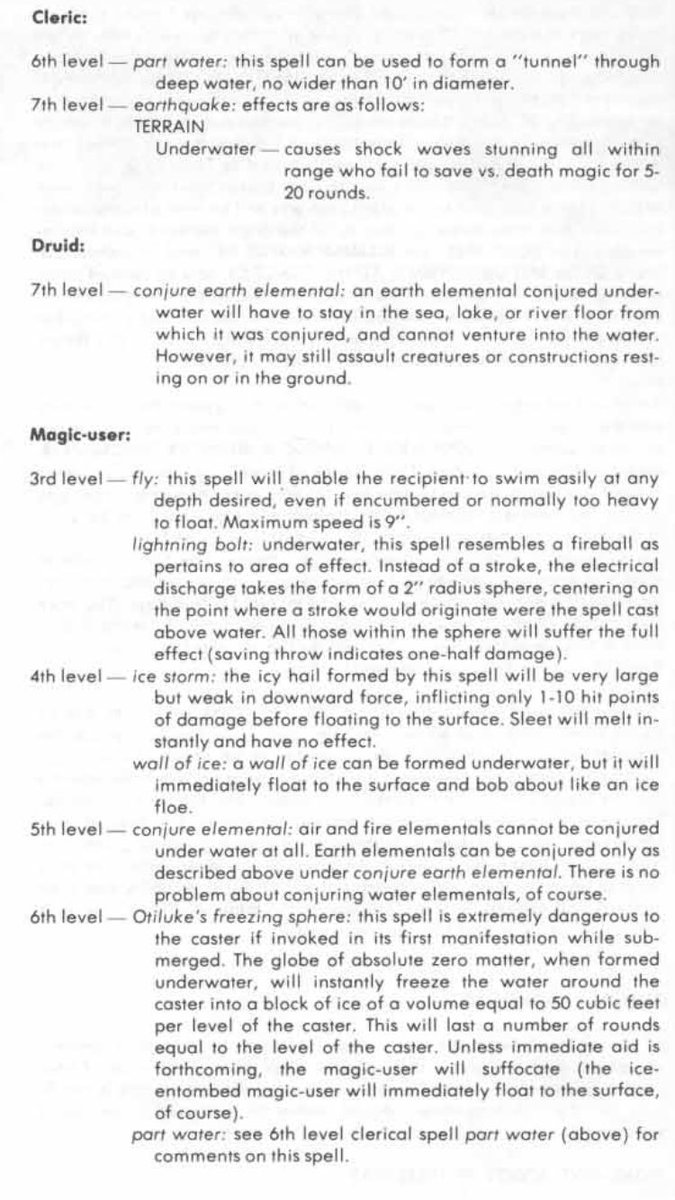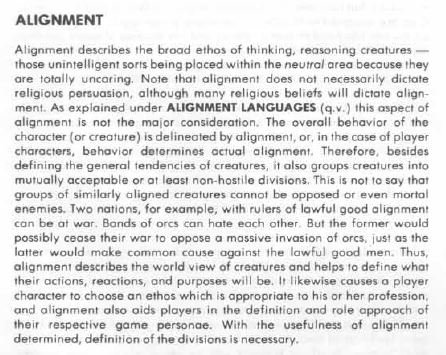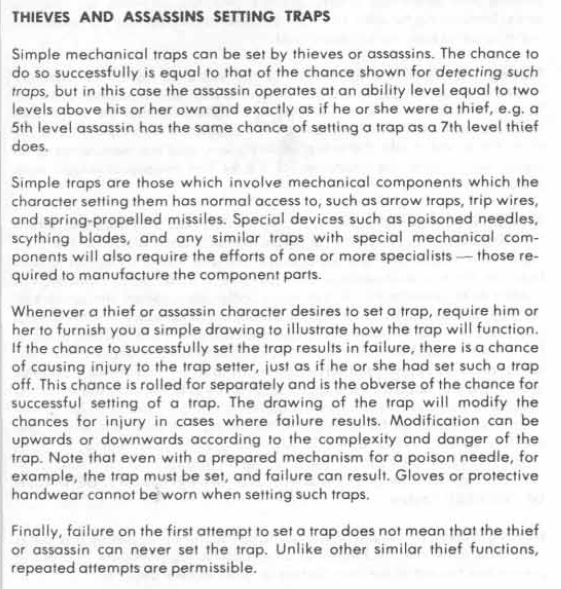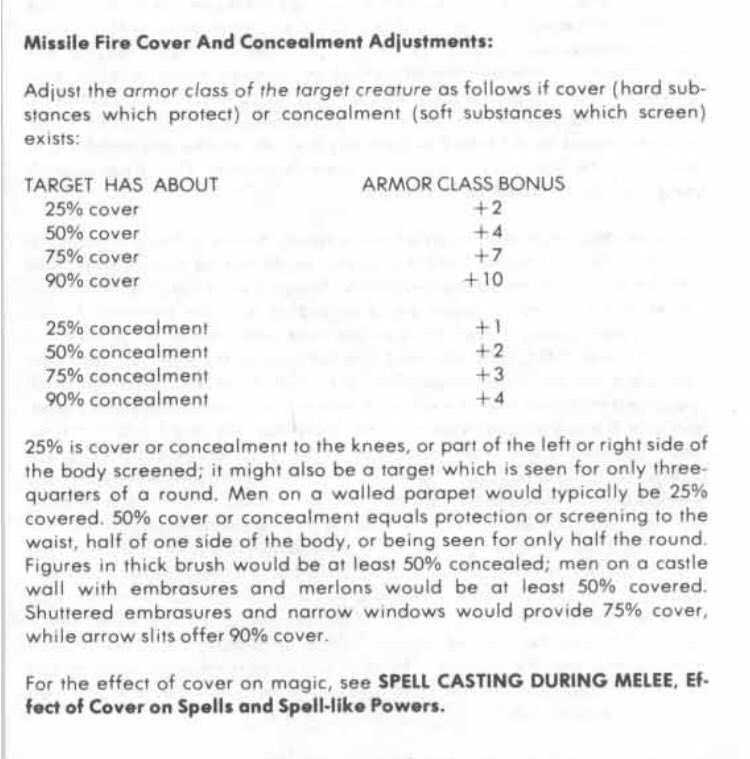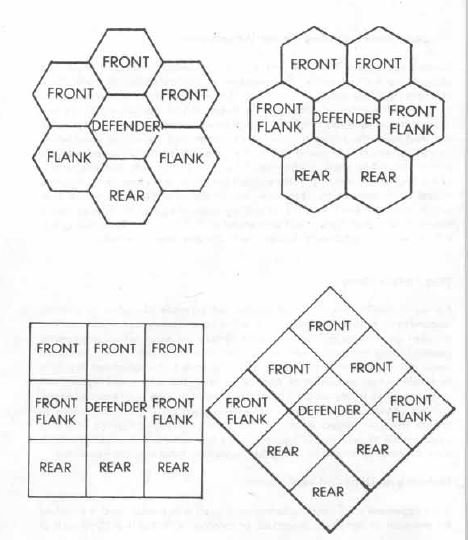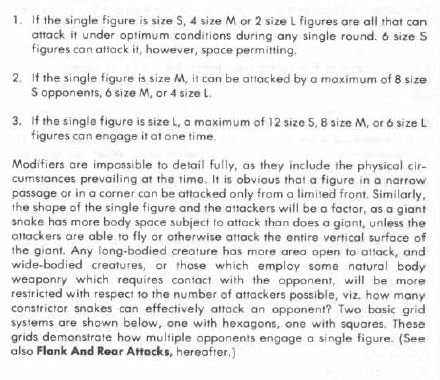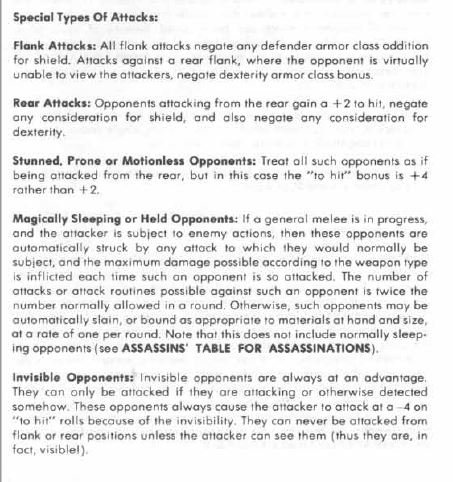I see a lot of bashing of early edition D&D around here, but I wonder how familiar people actually are with the game. 1e AD&D has a lot of rules people don’t know, and many of them are interesting and well designed. #DnD #ADnD
So I’m going to do a series of tweets where I outline the brilliant rules in AD&D. THIS ISN’T A KNOCK AGAINST ANY OTHER SYSTEM, it’s a celebration of what works well in early edition D&D (not everything does!) You might find things you can pinch for your game.
First off, people often ask how to make NPCs more interesting, enter the Personae of NPCs tables! You can improvise this stuff, but in a pinch you can also roll for characteristics like personality, piety or interests.
Continuing my thread of awesome 1e AD&D rules, today it’s the scroll spell casting system. People have criticized the 1e spell system before, but they tend to ignore the full scope of system, like the scroll casting rules.
AD&D makes a magic-user roll to see if they “know” a listed spell (eg can cast the spell if they have it), based on intelligence, so there are spells you can’t memorize and use. I like this as it helps to differentiate magic-users.
However, even if you fail your roll “to know” a spell you can still cast it from a scroll, this gives a “back door” so no spell is completely beyond a PCs ability to use, but some are still quite restricted.
In addition, a magic-user can also cast a more powerful spell than their level would allow if the spell is cast directly from a scroll. The cost is that they use up the scroll spell and can’t transcribe it to their book for regular use later.
1e assigns a failure chance and a chance of reverse/harmful effects when a MU casts a higher level spell this way. The chance of failure is 5% x [level needed to cast spell - current level]
So a 1st level MU casting a 3rd level spell (normally only possible for a caster of 5th and higher level) would have a 20% chance of failure. The chance for harmful result(from the table) is then 15%.
What is brilliant about this is that the odds of *harmful* failure are pretty low, as Gygax used nested probabilities. The odds of the aforementioned MU getting a *harmful* result in this case are 20% x 15% = 3%
This is the perfect mix, odds of failure are non-trivial, but odds of harmful failure are low, and it’s simple to calculate. This tempts players to use the spell before they are high enough level to be able to memorize and regularly cast it.
But it also gives them a “Hail Mary” option that isn’t overpowered as once used it’s gone. My players *LOVE* this mechanic, it helps to give a low level spell caster some love without giving them too much power too soon. And it can produce spectacular results!
Gygax was very good at creating risk/reward mechanics, this is a perfect example: give up regular future access to a high level spell in exchange for the possibility of casting it at low level and having it spectacularly succeed or catastrophically fail.
This is one of the reasons I cringe when someone says Gygax wasn’t a good game designer or he wasn’t creative, 1e is filled with brilliant rules like this one, that elegantly succeed in something (well balanced risk/reward) that many modern games struggle with.
And the best part is that you can import this system into any game that assigns castable spells by level progression (I assume 5e does this, though I don’t know if it uses the 1e scroll casting rules)
Would it make more sense to tweet each new example separately or just keep adding to this thread? I have a few examples 

Next up in the “why first edition is fabulous” thread is the spell casting system. People bag on the first edition system, but it works remarkably well at differentiating the classes (adding flavor to the game) and restricting the power of spell casters.
Anyone who has played the game for any length of time can tell you that spell casters can dominate the game at mid to high levels. I’ve seen many such complaints voiced about newer editions and other games, which try to “balance” this beefing up other classes with feats and such
1e deals with this as it deals with most issues: resource management! The spell system uses slots, you get so many per day, and once cast the spell is wiped from the mind. Spell casters have to rest then memorize/pray for their spells each day.
This puts a restriction on spell casters, there are only so many slots, they can’t just call up whatever spell they need on the spot, and they have to plan for rest and memorization/prayer time. While adventuring it is not always possible to stop/rest and prepare new spells.
Spells have components, verbal, somatic and material. Verbal and somatic requirements mean a caster who is bound or gagged won’t be able to cast certain spells. Also, material components can be rare or expensive, and can be lost/destroyed, nullifying spell casting ability.
Also, if struck while casting a spell the spell is lost, a crucial limitation on the power of spell casters, as this means they must be protected in melee to be able to cast spells successfully. This rule alone inspired some of the best tactical play I’ve seen over the years.
And then there are the class differences. These are what make the system flavorful, and flavor is so important to the game. There are schools of magic, each class has access to more of some schools than others, one immediate difference
Magic-user spells have the greatest scope of offensive, defensive and miscellaneous spells, clerical spells tend to be more protective / miscellaneous, druid spells are focused on nature, and illusionist spells on deception/redirection
People often think that magic-users get the best deal in all of this, as they have the greatest scope of spells, and some of the most useful offensive spells in the game. However…
… magic user spells tend to require more components and more expensive components, whereas clerics get to use their holy symbol as a component for many spells, druids use mistletoe (or substitutes) and illusionists have fewer material components for their spells than magic-users
Also, magic user and illusionist spells have to be found, clerical and druidic spells are all available for the caster at the appropriate level, they just have to pray for them. This difference is huge, as clerics and druids get access to the whole list of spells at each level
Other differences: clerics get bonus spells if they have a high wisdom score (13 or more), illusionists can use certain MU spells, and magic-user and illusionist spells also have on average shorter casting times, so they are less likely to be interrupted
The system restricts magic users with the most demanding material component outlay and the need to find spells, it restricts all casters by using slots, requiring VSM components, requiring spells to be rememorized/prayed for, and interrupting spells when the caster is struck
The 1e system is also customizable as there are multiple restrictions on spell casters, and it is possible to drop any one of them without significantly altering things. Rather than “oversimplify” the spell system, it is modular enough that it can be customized.
For example, substitute material components for spells, dropping the need to memorize individual spells and allowing free-casting, allowing multiple memorization of single spells, or allowing MU’s to have a single item (like a wand) as the material component for their spells
I've seen all of these done over the years (and I've done a few of them myself). A more "simplified" system, preferred by many for game play, doesn't allow this sort of customization, something I consider a strength of 1e.
There are also rules for creating new spells in the DMG for both the DM and the players, which makes the system uniquely open ended. Every campaign can add to the list of spells available in the game, and in doing so expand the game for your campaign in a unique way
All in all the 1e system gives you a customizable, expandable system that restricts the power of the spell casting classes while also differentiating them in interesting ways. Considering that the biggest complaints I see about spell casting systems are...
... that they are too powerful, that magic isn't that flavorful, or that they can't be easily customized, 1e has a lot to reccomend it. Add the scroll casting system to the mix to address spells not known and higher level spells, and the 1e system really shines
Next in our review of 1e’s best features: hit points. Ahh, but you say, most games have hit points, so why is this a 1e thing? Well, Gygax explicitly discussed the way HP broke down. And when you do that...
... it ends up that 1e HP are mostly non-physical, once you get beyond about first level. 0-level types in 1e have 1-6hp, so that 10th level fighter Gygax mentions is either rhino sized or lucky, fast and favored by Thor.
Note, I’m not saying Gygax invented abstract HP for 1e, I’m saying how he formally cashed out the abstraction is a good design decision
HP in 1e are *mainly* luck points, or dodge points, or god points. So what 1e brings to the table is a formalization of the HP abstraction, HP are primarily non-physical, and all non-physical factors are bundled together.
A good indication that people don’t really understand this is found at gaming tables, where DMs describe almost every successful to hit roll on a PC in physical terms, even though HP is primarily non-physical for PCs of level 2 and higher.
IMC until a fixed threshold of total target HP is crossed, successful attacks against targets don’t physically contact them, the damage applies to the non-physical component of HP (luck, dodging, etc.) and is described that way.
I’m not aware if earlier editions explicitly discussed the HP abstraction the way 1e does, if they did, they can claim pedigree, but treating HP as primarily non-physical, and not treating the non-physical factors separately, is a clever design decision.
It saves the PC the process of deciding to use their “luck points” to save them from a blow, it saves the designer from introducing a dodging mechanic or “God’s aid” system, all of these are rolled into one abstract number.
Gygax does a lot of this sort of abstraction, the one minute melee round is another example (more on that later), it has some limitations but it does simplify while allowing allowing you to add complexity later if desired
Up next: encumbrance! I think encumbrance is a vital part of the game. I don’t understand why people think it is so fiddly, like many other mechanics in the game you “pre-load” the work before the play session, so you don’t really have to do much with it during play.
It rewards characters who don’t try to carry everything in the book, and it rewards magic-users and thieves who wear lighter armor and carry fewer and lighter weapons. Many monsters in the MM have movement rates lower than 12”, so being light on your feet is life saving.
Importantly, it creates a cost to wearing armor, and thus fits into the 1e “resource management” framework. Making choices about tradeoffs like this is one of the core features of 1e play, and something that gives the edition its unique flavor
Here is how 1e does it:
1. Calculate your encumbrance – weight in pounds of all your equipment, clothing and armor, when you create your character.
1. Calculate your encumbrance – weight in pounds of all your equipment, clothing and armor, when you create your character.
2. Adjust for strength and this gives you a movement rate, if your base move with armor is lower, you take the lower movement rate of the armor.
3. You note how much more you can carry before you shift up a movement category, and how much you have to drop to shift down
3. You note how much more you can carry before you shift up a movement category, and how much you have to drop to shift down
In practice we don't bother to check encumbrance after chargen unless the PC picks up something particularly heavy. Players also note what they would have to drop to move up a movement category, e.g. drop your pack to increase your move from 9" to 12"
I've seen some clever abstract systems, and they work too, but 1e's system is quite simple once you realize you only need to establish the base encumbrance once at chargen then note the ranges for increasing or decreasing speed.
There are a lot of features of 1e that are like this, they *look* fiddly and complicated, but they are pre-loaded into the character then during play you hardly need them. I think this is an intentional design feature and a brilliant one.
Next up in the 1e is fabulous thread - rules for fighters! I’ve seen games and editions that beef up the fighter too much, making them into cuisinart’s with their swords by adding attacks and feats. 1e’s fighter progression was elegant.
First off, fighter’s can wear all armor, get the most weapon proficiencies, get new proficiencies more often than other classes (except the monk) and have the smallest non-proficiency penalties. Given the proportion of magical weapons in the DMG this is a class advantage
Fighters also get access to any weapon in the game, a first level fighter can have a melee weapon, a missile weapon, a long weapon and a blunt weapon, which makes them incredibly versatile.
Also, if you use the full range of weapon stats (eg speed, space required, weight, WvrsAC, weapon special abilities like spetum disarming) then the fighter’s comparative advantage is greater. Gygax’s system was integrated like that.
Then the “to hit” tables, not only do fighters get the best advancement, but you have the option to do per level to hit advancement of desired. One of the challenges of 1e is that these rules are spread out and hard to find.
This rule is particularly brilliant. One attack per level of experience against 0-level foes includes attacks against soldiers, city guards, mercs, etc. Some DM’s give levels to most of these NPCs, but by default most are 0-levels. I think this is elegant, nested design.
And the multiple attacks per round against all foes at 7th level. BITD every fighter in the game lusted after 7th level, multiple attacks per round are enormously useful, holding that off until 7th really helped keep things reasonable.
1e is one of those games that rewards understanding of how the pieces fit together, all of the aforementioned rules make fighters versatile but not overpowered, something that later editions tried to duplicate with varying success
Next up - Spells! 1e has some “broken” spells, but that’s in part due to the sheer scope, there are 400+ spells in the PHB! People complain about the “sprawl” of 1e and the flaws, but just for spells alone 1e outstrips almost every other fantasy RPG for the base game. Long post!
And the spells themselves have some interesting aspects that are forgotten: they aren’t “balanced”, they often have dark themes, and many exemplify the risk/reward/resource management aspect of the game
One of the cleverest aspects of 1e spells is their lack of overall balance, between or within classes, when combined with random allocation of spells and “to know” rolls this feature virtually guarantees magic users to be tactically opaque.
Take “sleep” for example, as a first level spell it is far more powerful than most first level spells, or stinking cloud, a second level spell which can immobilize opponents without a save.
Every class has a few of these overpowered spells, and ran BTB the MU can’t guarantee they will get them. This incentivizes creative play to obtain them, and makes it harder for the party to assess the risk of an enemy wizard.
And due to the scroll casting system, even a 1st level MU has a chance of being able to cast a high level spell, so finding a high level spell (easily done on the treasure tables) creates an instant resource management challenge: cast the spell or save for the spell book
1e magic is seen as “bland”, so some suggest darker themes (necromancy, the “cost” of magic) need to be added to the game, but these themes are already there in 1e spells! Elementals turning on their summoners is a great example, as written summoning elementals is very Elric.
Polymorphing gives the target a chance of losing their minds, teleport can send you into the ground, magic jar is... evil! 1e spells are darker than they appear, something forgotten when you focus on the spell slot system or the spells with errors in them.
Flavor! 1e spells ooze flavor. Material components (eat a live spider for spider climb), effects (disappear into an extra-dimensional space for rope trick), phantom steed (“...They do not fight, but all normal animals shun them, so only monstrous ones will attack”)
And then class differences, Cleric spells take longer to cast but clerics can pray for any spell on the list rather than having to acquire them “in the wild”. Illusionists can use any cross listed MU spell (but not vice versa)
Druids have mistletoe as a material component but less efficacious substitutes are allowed, clerics can use their holy symbols as a material component for many spells. Actually, 1e suggests that the DM could allow substitutes for any spell components, for variable effects.
Illusionists! Their spells are written in a non-magical language, and as they increase in level their spells become more real. And to cast phantasmal force the illusionist has to have seen the subject of the illusion before, so every encounter they survive adds to their arsenal
Lastly, DM’s and PCs can research their own spells, modules often included a few new spells and items to give the flavor, and the DMG discusses the details of the process. Every DM I know has tried her hand at making spells, it adds local flava to the game.
Abundant choice, random spell allocation, “to know” rolls, uneven spell power levels, material components, scroll casting, homebrew spells and flava! 1e’s spells bring a lot to the table, and are one of the best designed features of the game.
But wait! There are some badly designed spells in 1e! Yes, Flame Arrow, identify and Enchant an item are borked, but in a game with 400+ spells I have needed to “fix” about 10.
1e allows you to go to other planes, encounter gods, time travel, teleport, become invisible and read other minds. 1e spells do a ton of things, Gygax gives you all the relevant stats (range, AOE, components, etc.), a description of its execution, and leaves the rest to you
For example, what does a magic missile look like? Can it target a non-living object? If I know someone is around a corner can I target them with a MM? Spells are a rabbit hole of complexities as they interact with the game environment.
The brilliance of this design is that it allows you to flavor your world through magic, it doesn’t impose it. It encourages tinkering and experimenting, YOU decide if something picked up by an invisible party member becomes invisible too.
This is what I like about 1e, it gives you what you need, but you have to flesh it out to make it work best. That may look like bad design, but it’s actually quite brilliant. What I disliked about other editions and games was how much of this was baked in.
People get distracted by the crunch of 1e, but most of that was optional, the meat was strong base mechanics for a remarkably diverse game, 1e had conversion rules for Boot Hill and Metamorphosis Alpha, modules like Barrier Peaks & books like D&DG
Next up in the good 1e design thread: saving throws. Although 1e did have several examples of ability checks (e.g. intelligence for phantasmal killer) it’s primary mechanism was the saving throw.
I don’t like ability checks for 1e as abilities are generally pretty static, so a brand new adventurer and a seasoned veteran with similar ability scores have similar chances, and they don’t change.
The 1e saving throw tables incorporate level, class and ability scores into the mix. As you level your saves improve, the rate of progression linked to the level spread on the table and class XP requirements.
So for example, at 10,000 XP spell and RSW saves from best to worst are MU, thieves, clerics and fighters. MUs do well against magic saves, clerics do well overall as “favored of the gods”
Thieves do well across the board due to fast leveling, these are class advantages to MU’s, thieves and clerics that go unnoticed as they aren’t detailed in the class descriptions.
Ability scores influence saves as well, dexterity Defensive Adjustment applies to any dodge based saves, Wisdom magical attack adjustment applies to mental saves.
Since 1e did not have an explicit mechanism for “feats”, it was up to the DM to decide how to adjudicate “swinging from the chandelier and landing on the ogre” actions. Since breath weapon saves are agility and timing based, that’s what I use.
The saving throw system is good design as it incorporates multiple factors to decide success but bakes them into a table to avoid excess crunch. This is a general feature of 1e design that is often overlooked when assessing crunch.
When I discovered this section of the DMG BITD it changed everything about my game. Morale rules meant that enemies can flee rather than fight to the death. The modifiers are easy to apply and intuitive, and the odds of morale failure are well constructed. #DnD #OSRIC
What this meant was that a non-trivial amount of the time monsters & NPC opponents would flee or surrender rather than fight to the bitter end. It made my players more tactical (targeting the leader raised the chances of breaking morale) and it kept the game from becoming a slog
Tthe morale rules presented in the 1e PHB are system neutral as there is a base percentage plus modifiers that aren’t specific to the 1e stats. So no matter what system you use, you can borrow these if you are interested. If you don’t use morale rules, I highly recommend them.
Before we get to today’s good 1e game design featurea brief aside. I like my combat crunchy and my role play light. Not everyone fits that description. But that doesn’t mean I don’t like role play, I’d conservatively estimate my game is about 60-70% role play, 30-40% combat.
I like the freedom of being able to play my NPCs loosely. Excessive role-playing rules structure takes away from that. Also, rolling dice in combat is streamlined, when I’m role-playing I don’t want to break immersion by repeatedly consulting dice to resolve how the NPCs react.
I have a wealth of experience with the PCs and the game world, and all of that comes to bear when role-playing a NPC. So what I want is a mechanic that I can use to determine how the NPC will react, in a general way, when I’m not sure how they will react.
Also, I want to keep on my toes, there is a real risk when running a game that your NPCS all start to seem the same, or that you default to certain kinds of responses. Your players pick up on this. So what I want is a light mechanic to randomize reactions a bit.
Enter the 1e Encounter Reaction table. It is used for two general situations. First, when the PCs parley with a NPC/Monster that can understand them, you roll to see the reaction. This rule alone has changed the tone of the game considerably.
Second, when dealing with a NPC in a non-combat situation, I use the encounter reaction table to determine their reaction to the PC’s words and actions when I’m not sure of the outcome. Haggling with the shopkeep about the price of those weapons? Roll an encounter reaction
I also like this mechanic as an example of the Roll Randomly and Explain it (RRTEI) principle, one of the bedrocks of old-school role play. If the table gives you an unusual result it's a creative fulcrum to come up with an explanation why the NPC/Monster reacted that way.
This principle alone has generated some of the best adventuring and role playing in our game. Coming up with that explanation of the NPC’s decision has led me to create interesting adventure hooks and flavor
Here’s an example, party was haggling with the local seller of mounts (IMC giant lizards, giant frogs and giant boars). I obtained an “enthusiastically friendly” result, so I had to explain why the seller was so generous with the PCs.
I decided that he had been robbed recently, & desperately needed to sell some stock to make up the loss. When he explained this to the party (“I normally don’t sell these so cheap, but…”) they offered to find the thieves, and that was the next two sessions (entirely improvised)
The other thing I love about this mechanic is that it is modified by charisma, so it gives high charisma characters an important role. The current high-charisma thief in my Thursday game does all the haggling, parley and interaction for the party and has proven extremely useful.
Particularly if you run an urban adventure, being in the city means a lot of discussion and role-play with NPCs, the encounter reaction table keeps this all fresh and interesting, but doesn’t bog it down in excessive rules and structure.
Since this came up in another thread, the next 1e design feature is the city encounter tables. How does 1e’s handle urban encounters? Just like outdoor or dungeon encounters? Is violence the most likely outcome? Long entry because I want to be clear on this.
The assumption is that 1e handles everything in the same way and the mechanics produce similar results for an urban game as they would for a wilderness or dungeon game. Specifically, that the game defaults to violence.
What do the rules say? First off, there are no base odds given of an encounter occurring. Gygax leaves this to you, allowing you to calibrate this to your city setting. As a guideline the odds of land encounters in a densely populated are 1 in 20
The general trend is lower odds in more populated area, indicating that greater population density means some degree of anonymity, the more people around the less likely an encounter of note.
I’ve seen published city settings use 1 in 20 to 1 in 10 odds, so that’s up to you. Let’s use 1 in 12 as our benchmark.
Now look at Gygax’s sample city encounter matrix. Take a look at the spread of results.
17 monsters
19 0-levels
10 classed NPCs
17 monsters
19 0-levels
10 classed NPCs
Encounters with 0-levels (several shown here) will only result in violence if the party is belligerent. So for most of these if the party wants to play it cool there is no need for violence.
Encounters with classed NPCs (shown below) are likely to lead to nothing unless the party are provocative. Fighters/rangers/paladins are indifferent to the party members, MUs and Druids ignore most, Clerics might try to convert.
So for approximately 2/3 of the results, violence is only likely if the party invites it. But what about the monsters? Surely they will lead to violence in most cases, and they are a 1/3 of the table. Also, you check for encounters every 1/2 hr.
However, here Gygax does something brilliant, he tells you to interpret the results. Which means that during broad daylight you won’t be encountering a night hag, no ghosts in city squares, so many monster results are ignored.
What this leaves you with is that during the day or in busy areas violence, even with monsters, is only likely if the players get belligerent. At night in less populated areas, the risks are higher. This makes sense
Two other things. First, leveled NPCs and 0-levels use the encounter reaction table to determine reactions (unless the PCs are hostile) so the reaction isn’t always violent, even at night or in a dodgy area
Also, a high charisma PC can be the difference between a violent encounter and an opportunity. A non-hostile party that rolls well due to the high charisma modifier can get a strongly positive reaction.
Now some approximate odds. Say the party is crossing the city from their inn to consult a sage. It’s a 1/2 hour to get there. 1 in 12 chance of an encounter, but during the day in common areas violence is unlikely.
If they travel at night in shady areas their odds of getting a hostile encounter over a 1/2 hr trip are still low, 1 in 12, so the idea that violent reactions are most likely is simply false.
This is elegant design, you could run an urban campaign off this table or one like it, and it would be as violent as your party wants it to be. It can prioritize RP. Also, Gygax plants ample adventure seeds in this table. Check out these entries.
This is a great example, everyone focuses on the saucy terminology, but look at the nuance in this entry. There are many different motivations for the NPCs, the possibility of information for the party, deception or assault.
These tables drip flavor and are built to create possibilities for play, they are robust, generative and lend themselves to role play over combat in many cases. I based the design of my city encounter tables off the mechanics of these.
Having variable use tables (where time of day and location nullify certain results and many entries default to ignoring the party unless provoked) is good design as it reacts primarily to the actions of the PCs
So the game adjusts to your party’s style of play. Don’t believe it when anyone suggests that 1e defaults to “hack and slash” in any setting, or that it cant handle urban fantasy without becoming a dungeon crawl. It’s far more elegant than that.
Today’s good 1e design feature is the spell interruption rule. If any attack lands on a spell caster before their spell is cast (e.g. the opponent wins initiative and is successful in their attack when a spell caster is casting a spell) the spell is broken and lost from memory.
This is one of those “small” rules that has a big impact on the game. Spells are hard to find, have to be memorized, and can take time to cast (increasing time as the spell level increases for the most part). So the possibility of interruption is significant.
BITD this led us (after a few initial sessions where our MU’s got creamed) to use “fire teams” pairs of “caster + tank” in order to ensure that the spell caster would have a fighting chance of getting the spell out successfully. I’ve seen this solution used by many groups.
Someone imposing themselves between a spell caster and their enemies acts as cover for the spell caster against missile weapons, effectively lowering their AC, and forcing any melee combatants to engage them first .
1e rules force you tomanage your resources such that you can deliver when needed. The spell interruption rule led to cooperation by necessity, one of the reasons I often say that in 1e teamwork is “baked into the game”, in the class structure for example, and in this
And on the flip side, the rule leads players to realize that they don’t need to kill enemy casters to have an impact on combat, interrupt their spell casting and that can be enough. This makes missile fire even more important to the party’s tactical arsenal
It also makes spells like magic missile and shield important. Magic missile has a 1 segment casting time, great range and target’s unerringly. So MM is the “spell interrupting spell”, it isn’t just for doing pew pew damage. If you have it, MM is ALWAYS worth memorizing.
And the spell shield becomes more important as it neutralizes MM spells, so in a game world where MM is a go to spell for interrupting other spell casters, shield becomes a go-to spell to protect casters from interruption when facing other casters
I love how the interactive complexity of 1e leads to tactical game play decisions and spell choices to reflect connections between disparate bits of the game. Once the players make connections the game world becomes rich and “real”, reacting in complex ways to their actions
Today’s good design feature: the XP system. I see a lot of hand wringing on Twitter about XP, how to award it, and how complex the system is. 1e does a surprisingly good job of this.
The first feature I like is that in 1e XP value from greatest to least is gold - magic items - monsters. For a “hack and slash” game this might be a surprise, but 1e gives the least XP for monster slaying
But that’s not all, because you get the most XP for GP, it doesn’t matter how you get the gold, so the 1e system is compatible with whatever style of play works for your group, if you want to parley, fight, deceive or sneak, it’s all good
This feature alone makes the 1e system far more flexible than systems that assign XP based on task, as there are many different ways to complete a task these systems put a burden on the DM to weigh them out.
It also allows you to run an adventuring party like a group of mercenaries, they do jobs and get paid and the pay directly translates to XP, so if you don’t want to have dungeons brimming with gold, you can still use the system.
This is why people who claim D&D is a hack and slash game are revealing their ignorance of the rules as written, it can be played that way, but it wasn’t designed that way. So play style is on the group, not the game.
Second, XP for an encounter are divided between all players who took part in any way, 1e assumes that combat involves teamwork and even the character who only does something small in the battle gets an equal share.
I like this as it reinforces the teamwork aspect of the game and helps to prevent powergamers from attempting to dominate the game just to hoard XP. It also simplified the DMs job considerably.
Third, you adjust the encounter XP based on challenge, essentially dividing adjusted monster HD by total character levels, if the character levels exceeds the monster HD you multiply the XP by the fraction, reducing it
Once you have done this a few times it’s pretty simple, and it supports the “lumpy” aspect of 1e, encounters aren’t balanced, so the easy ones don’t contribute as much.
Fourth, you can sell your magic items for gold and get the XP for that, but only before getting the XP for that adventure. If you sell it after leveling up there are no XP to be had. This gives the PCs a resource management challenge.
Fifth, training takes time and gold, but it is possible for players who play well to self train, though it doubles the time required. Training is expensive, but a service/exchange can be used to pay for training as well.
This is important as many dislike the break in adventuring that training requires, going “back to civilization” to find your trainer can be disruptive, but Gygax anticipates this and allows for self training.
As an aside I love how Gygax’s throwaway comments can inspire RP goodness. One of my players used the service/exchange caveat as the basis for asking her trainer to accept a service for training, and a side adventure was born.
You can modify these rules to fit the circumstances. Some DMs drop the ratings system, others reduce costs. Gygax himself made exceptions, in the G series he explicitly suggests allowing PCs to level on site as the module is challenging
I don’t like the rule that you can’t keep gaining XP once you have enough to gain a level without training for that level first. With variable XP tables and a large party this becomes too disruptive. I allow multiple level acquisition where applicable.
In today’s design 1e features thread, I want to consider the subject of simulation versus narrative in RPGs. Due to the crunch of 1e combat many people think of older edition D&D as a simulationist game. Variable weapon damage and weapon speed, POLEARMS! Crunch, crunch, crunch.
However, this would be a mistake. Gygax was not a simulationist, he states in several places that making the game too realistic would bog it down and make it unplayable. For example, a discussion of hit points he makes clear that location of hit and type of damage are unimportant
His discussion of saving throws is similar, he believes that characters should almost always get a chance at a saving throw, no matter how extreme the circumstances, even if this isn’t “realistic”. He specifically cites the fantasy literature as his inspiration for this.
These are explicitly narrative elements, they allow the PC to survive when they otherwise would not, and the only reason for this is that 1e was meant to emulate fantasy fiction, where the hero survives despite the odds, and manages to live another day.
So why the insistence that “modern” D&D is more about narrative than simulation and crunch? Well, this is another one of the great design features of 1e (IMO), Gygax baked the narrative element into the game, rather than leaving it as a mechanic for the players to use.
Can you imagine if Gygax had said: “At 1st level your PC gets dX roll for hit points to represent their physical toughness. Every level after they get a dX roll for ‘story points’ that represent their ability to survive remarkable situations, just like fantasy fiction heroes.”
Modern narrative tools, “luck points” and such allow players to decide when they want to alter results, and to become involved in the process of shaping the story the game is telling. I get the appeal of these systems, but one thing they all do for me is break immersion
Why? Because a result is determined then changed. It is changed by the player, but for me that feels no different than the DM fudging a roll. One of the most appealing aspects of 1e for me is that you can't change a result except through your actions in the game
The “resistance” of the game creates verisimilitude & immersion. Gygax’s brilliance was to hide the narrative elements in the game mechanics, so they feel organic and independent of the players. Hit points & saving throws are NARRATIVE TOOLS, they make the game more like a story
So people looking down their nose at 1e and older editions as mechanically focused crunch, who view the “renaissance” in modern D&D as a significant narrativist break in focus with the simulationist and wargaming roots of older editions, are fundamentally mistaken
1e is not a simulationist game, neither is it a cooperative narrative game where the players actively change results to shape the story, instead it is a blend of the two which favors abstraction & hides the narrative elements in the game mechanics to create a more immersive game
To me this is one of the best design features of 1e, it feels “real”, in that there are elements in the game beyond your control, but your character can still feel like a fantasy hero from the stories that inspired the game
Today’s entry: the potion creation rules. Ask anyone why they play 1e despite the “challenges” of deciphering it, and one answer I always hear is “flavor”. 1e oozes flavor from every page. These rules are a perfect example of how Gygax gives you more than just rules #DnD #OSRIC
First , he restricts potion making to 7th level MU’s and higher, and even for that 7th level MU an alchemist is also needed. This means your first level party won’t be brewing up potions for your game, and of course potions are temporary magic items, so they aren’t game breaking
There is a simple cost and time formula, cleverly based on the XP award for the potion, cost and time variables are a huge part of 1e’s design aesthetic of resource management, and Gygax uses them here to good advantage.
Now, this is nice and all that, but it’s a niche rule, my games don’t get to 7th level, my players don’t want to brew potions, etc, etc. One of the reasons I like 1e so much is that it’s never just good game mechanical design, it’s also flavor and adventure seeds
Flavor: we have a listing of suggested components, not exhaustive, but enough to give you an idea of what would work IYC. My favorite is, “dust of freshly destroyed spectres or vampire brain or ghost ectoplasm or lich tongue” That’s just pure, distilled game flava right there
Gygax gives you options to tailor the rules, scroll manufacturing has a failure percentage, potion doesn't, but if you want one he suggests a system, then fits it elegantly into the rules by suggesting that failed potions become potions of delusion. That’s good design.
Adventure seeds: Your party of 1st level stalwarts have arrived in a small town, just on the outskirts they meet & defeat an ogre that has been picking off townsfolk for weeks. The townsfolk tell the local retired adventuring warlock that protects the town about their deed
The warlock is impressed with their ability, and old enough that he doesn’t want to adventure to get his material components anymore, so he hires the party to go out and get him things. There’s your campaign start for you, from one page of the DMG.
There is the seed of an encounter right there in the text about the alchemist, “… the alchemist will continually putter and experiment, always to no particular end, when not engaged in specific work for the magic-user”. But is it to no particular end? Maybe he’s up to something
And just to note, this is pretty system neutral, you could easily port it to any fantasy game system and use it there. There is a ton of this sort of easily convertable or immediately usable material in the 1e DMG. Well worth mining for any game.
This has it all, system neutral, simple integrated rules, balanced to avoid exploitation, resource management, flavor, adventure seeds and encounter ideas. I read other systems and I get one or two of these, maybe three, but Gygax delivers many or most of these regularly
Remember this when people criticize 1e’s design. Yes, it has flaws, and yes, it is HARD to read, but I would recommend reading it for any DM for any system, it’s overflowing with good design, and endlessly inspirational.
Today’s awesome 1e design feature: Appendix A - Random Dungeon Generation! Gygax, as a former Insurance adjuster, was fond of tables. Rather than just put in a dungeon map for you to copy he gave you tables to generate your own. #DnD #OSRIC
I’ve used these tables to generate dungeons in their entirety, I’ve used them when I was stuck as to where to go next in a dungeon I was designing, and I’ve perused them for ideas without rolling at all.
It can also be used real time, rolling for the next feature as the delvers explore in the dark. Given the speed of dungeon exploration this works remarkably well, and creates a unique, often unusual dungeon layout
As with all of his tables Gygax suggests you use it interpretively, if you get a result that doesn’t fit what you want just reroll it. The tables are meant, as most of the book is meant, as a source of inspiration.
Lots of game systems give you examples, what makes 1e’s design so exemplary is that Gygax didn’t just show you what to do, he showed you the mechanics of doing it. And using random generation ensured that you wouldn’t get the same thing over and over
And this is yet another system neutral set of rules, it could easily be ported into a 5e game or any fantasy setting.
Today’s cool 1e design feature: Appendix D: RANDOM GENERATION OF CREATURES FROM THE LOWER PLANES! Endless flavor, Gygax didn’t just give you rules for play, he gave you rules to create elements in the game
FLAVA! Look at these entries: antlers on a twitching crocodilian head with metallic swivel-socketed eyes, a stench of gangrenous rot follows in its wake. I could populate a monster manual of unique demons and devils with this
I’ve seen supplements that allow you to generate monsters for the game, some are very good, but few are as flavorful. And within the core rules. Grab some dice and in about 10 minutes you can have a completely unique lower planes monster for your game.
And it doesn’t have to be a demon or devil, you could use this table to create hybrid monsters brewed up in a warlock’s vats, or strange beasts made form degenerate necromantic magic.
Good design isn’t just final product you can use at the table, it’s pulling back the curtain to show how you can create new content. The 1st edition DMG was a game designers book, not just a Dungeon Master’s play manual
One of the reasons, IMO, that 1e encouraged DMs to homebrew and house rule is that Gygax put in things like this table, he showed you how to not just run a game but how to create new content, with rules for spells, magic items & monsters
1e is designed to be tinkered with, is a kit-bashing game, a brilliant design feature that accounts in part for the proliferation of retro-clones, editions and related games. The 1e DMG should be on every game designers shelf.
Anyone who suggests it should be tossed out due to its flaws, game mechanical or political (and I’ve seen it suggested for both reasons) is simply ignorant of its depth. I’d rather a flawed work of brilliance than a “perfect” but pedestrian tome.
Today’s 1e design feature is the Underwater Adventures section. Gygax was wordy in prose but surprisingly parsimonious in rules. This section gives you just enough to run the game and leaves the rest to you
A good design suggests adventure possibilities as well as mechanics, given how Gygax describes the impact of underwater action there are lots of adventuring possibilities here. Sahuagin tribes with giant nets and electric fireballs come to mind.
For combat his restrictions are flavorful, a prohibition on cleaving and crushing weapons makes sense and rewards the players who chose varied weapons.
Gygax selects out the spells that won’t function or have altered function underwater, but he leaves open the possibility that you might rule differently. The balance here is just right, a list of relevant spells...
... and some suggestive descriptions of what might happen and you are good to go. There is a tendency to want to figure out a rule to cover every possibility, instead a short section gives you the idea and some examples
Alignment, I’ve seen a few threads on this lately, and I thought it was worth discussing. I played for years without using it, and the game worked just fine. I had to adjust a few things, e.g. spells like protection from evil had to be house ruled, but it didn’t break anything.
I think alignment has it’s use in a D&D game, and it’s actually a good design feature when used properly. However, it has been massively misunderstood over the years, in part as the concept is misunderstood, and as it’s plugged into the overall game in a way that isn’t obvious
D&D is a game where the gods are “real”, they can be interacted with (there are rules for beseeching your god for aid, and all clerical spells are given by diving beings). In a world where the gods walk the earth so to speak, alignment is a useful tool to help organize things
Any world where the gods are real and opposed to each other (as mythology tells us) it makes sense that “lesser” beings would organize into opposing camps as well, and alignment describes those camps in a general way
There are magic items and spells that make alignment “real”, swords that damage their wielders if their alignment is different, spells that work against particular alignments. It’s one of the consequences of a fantasy world where magic is real and the gods are too.
The biggest misunderstanding about alignment is that alignment is NOT a player's tool, it's for the DM. Gygax states that alignment doesn’t dictate PC behavior, behavior dictates alignment. So that player who says “My PC is chaotic neutral, she'd do that!” is mistaken.
Alignment was never meant to box in PC’s, with the exception of Paladin’s and to a lesser extent Druids, who have specific behavioral requirements spelled out. The Druid’s are less constraining as true Neutral allows a wide scope of behaviour, Paladins less so.
Alignment for PC’s isn't PRESCRIPTIVE, it's DESCRIPTIVE. If your character behaves like she’s chaotic good then eventually she will be, what other characteristic of your PC does the DM have the ability to change like that?
Ideally, with the exception of Paladins, PC's shouldn't reference their alignment at all in game, they should play their characters as they like, and the DM can change alignment if needed.
This is FUNDAMENTALLY different than how I've seen alignment used by players at the table. It's almost always used as a role playing guide for players, when it is actually a tool for DMs. No wonder so many dislike it!
So those people objecting that it makes no sense that monsters are all one alignment are missing something important, alignment describes general tendencies, not specific actions. Alignment is not deterministic, it doesn’t determine exactly how a monster/NPC/PC behaves
The point of monster alignments is not to suggest that all monsters will behave a particular way all the time, it’s to give the DM a general guideline to follow. So for example, a Lawful Evil dragon might be more willing to bargain with the party than a chaotic evil dragon
A chaotic evil monster can cooperate with the party, or spare them in certain circumstances, it’s just less likely. Played loosely alignment is really just a starting point for the DM to characterize the creatures in the game world, it doesn’t lock you down at the table
It describes a “broad ethos of thinking”, it groups creatures into “mutually acceptable or at least non-hostile divisions”, but that still means that good creatures can be opposed to each other. Think of alignment like political affiliation, or someone’s general ethos of belief
So for example, someone might identify as a “liberal” and support equal rights and democratic institutions. But that doesn’t mean they will always vote for democrats, or that they support every liberal initiative, perhaps they believe in free markets and small government
Alignment is a general tendency, not an iron-fisted rule on how a creature will behave. Think of it as a role-playing cue for DM’s, it tells you the general tendencies of the creature in question, the default position , how that plays out specifically is up to the DM
Used properly it gives the DM a place to start from for role playing, and helps to differentiate opponents. PCs up against chaotic evil opponents are likely to have a different experience than against lawful evil opponents. Alignment helps the DM take a more nuanced approach
I’ve seen many people bemoan the lack of guidance in OSR games for role-playing, how do you role-play NPCs/Monsters? Alignment is a flexible tool for doing this if used non-deterministically as Gygax intended
Today's 1e good design feature: Linked and nested mechanics! In this case the rules for Thieves and Assassin's setting traps. Rather than creating a new table or new mechanic, Gygax links to the existing find/remove traps as the base mechanic.
Another example in this section, the chance of a trap harming the theif/assassin when setting it up is the obverse of the chance of successfully setting the trap. So here Gygax links to an existing mechanic again
So you roll for success, and if you fail you roll for the chance of harm. For example, a thief with a 40% chance to set the trap has a 60% chance of failing, & a 40% chance of harm, since you have to fail before the harm possible, the overall chance of harm is 60% x 40% = 24%
Nesting the mechanics like this (as he did with the scroll casting rules) makes the chance of harm lower, but doesn't eliminate it. This sort of game mechanical alchemy is great design and rarely acknowledged as such
You want to have reasonable risk and reward, and allow for different kinds of failure (harmful or non-harmful for example). Also, linking to existing mechanics makes the game simpler and more coherent.
Note also that Gygax REQUIRES a simple sketch of the proposed trap just to attempt the task, and suggests the drawing can modify the odds of success or failure for the trap. This is one of the oft cited aspects of 1e design - challenge the player, not the skill
I find this sort of thing encourages the player to go out and look for ideas, and to get creative in game, rather than just rolling for a skill then getting the result. This section distills a lot of what is well designed in 1e
Took a few days off from this thread as I’m rolling it out for my blog, it’s taking a while but when it’s finished I’ll link to the blog for those who don’t want to roll through the whole thread.
In the meantime, we had a big combat session today that reminded me of all the great combat rules in 1e. Everyone gets stopped at initiative because 1e init is such a mess, but there is more to combat than initiative!
Example 1 - concealment and cover bonuses. I still remember the day that I realized if a tank stood in front of my MU that would provide the equivalent of a 7 point AC bonus against missile fire. That’s pretty awesome.
1e even gives AC bonuses for concealment, a curtain in front of the MU provides an AC bonus, an illusion or a darkness spell could do the same, without being tangible at all.
Today’s good design feature of 1e – the close combat (melee) rules. There are a number of these, to be expected as D&D evolved out of wargames. These rules seem “fiddly” to some, but when taken together they make combat tactically rich and rewarding. #DnD #OSRIC
D&D was really moving into unknown territory BITD, so for example, the wide range of creatures in the game meant rules for how many figures can surround an opponent were necessary. Gygax even provided these handy hex/square grid illustrations to show how it works
These rules are simple and come into use remarkably often in regular play. They work for the players and the NPC/Monsters, and they are a useful limit on PCs or NPCs/Monsters “piling on” opponents.
There are a number of rules related to positioning, for example, attacks from the side negate the bonuses associated with shield and high dexterity. Attacks from behind get a bonus of +2 (compare with the +4 bonus for thief backstabs)
Attacks on magically sleeping or held opponents are particularly deadly. If during a melee such attacks automatically hit and do full damage. If outside of melee, held or sleeping opponents can be automatically slain. This makes spells like hold person and sleep EXTREMELY DEADLY
Invisibility also carries special bonuses, in addition to a generic -4 to hit, invisible opponents cannot be backstabbed or flank attacked
And here’s a little gem from 1e that people tend to dislike, the rules for breaking off from melee. The “free shot” at your fleeing opponent strikes some as unfair, but it makes the decision to engage in combat a more telling one.
1e makes combat deadly when you use the rules as written, if you choose to fight everything you encounter the odds are stacked against you. I think this is a good design feature of the game, as it means that those who play while ignoring tactical considerations will not last
1e is designed such that you can get *better* at it if you pay attention and learn the rules. That sounds obvious, but more “rules lite” games often lack this feature. It is precisely the fiddly bits, and their interconnection, that make it possible to become skilled at the game
This is a design feature of 1e that I really like, if you dive into the combat rules there are a lot of ways to get better, and that gives players something to strive for, and means that a more mature group will be better at the game

 Read on Twitter
Read on Twitter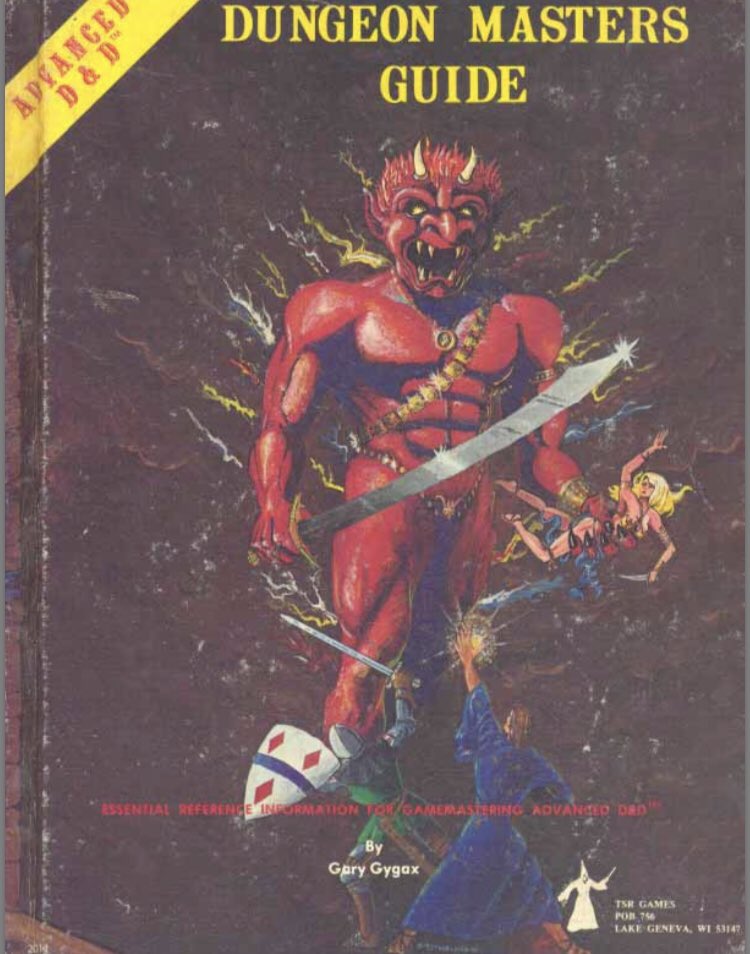
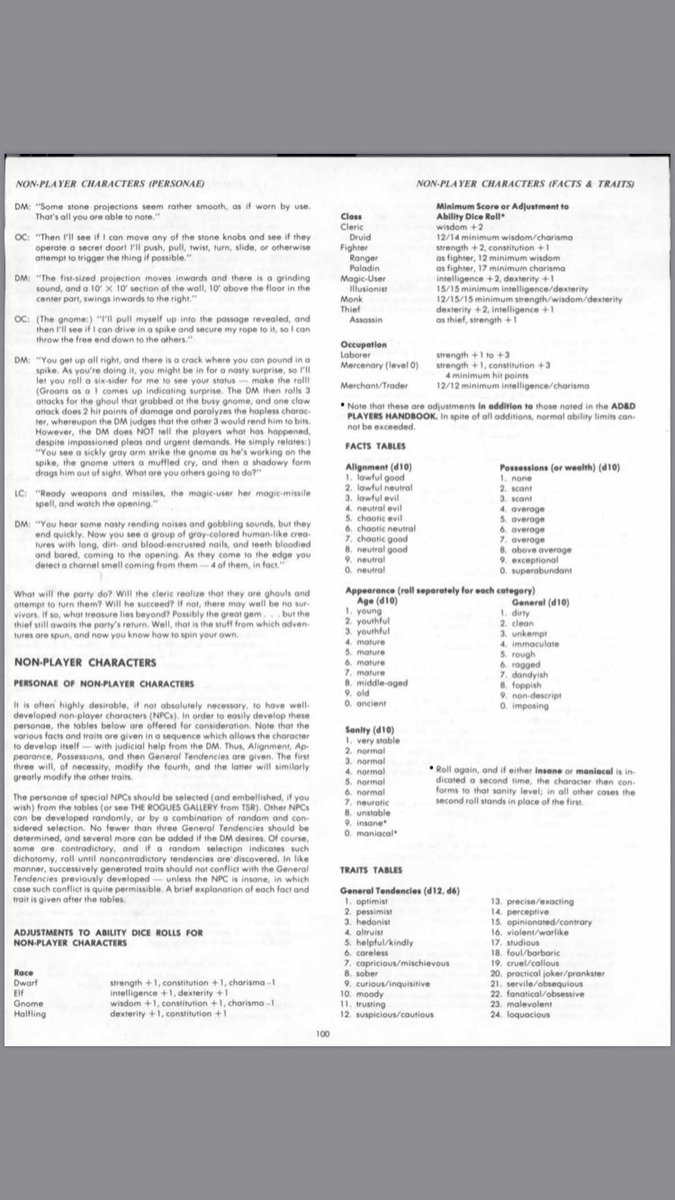
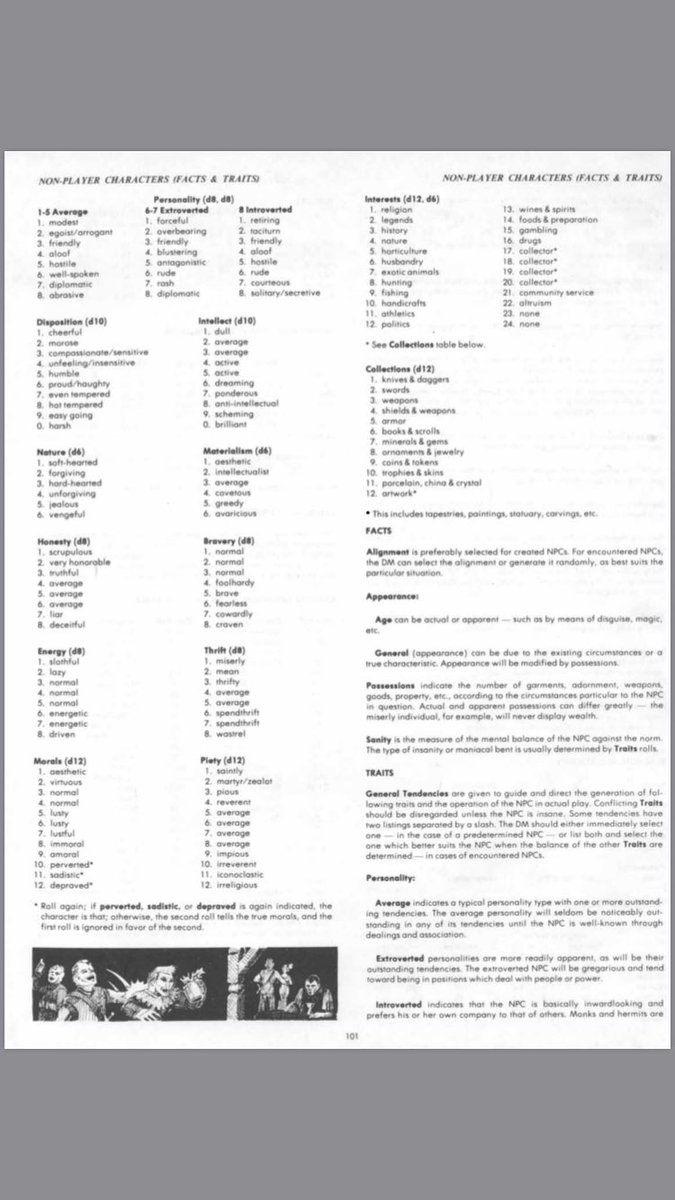

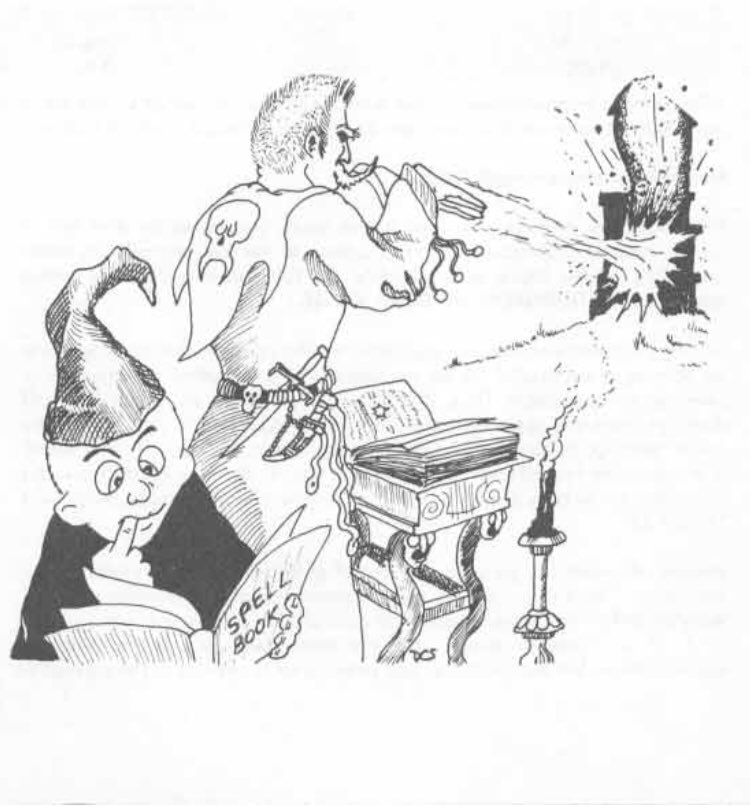
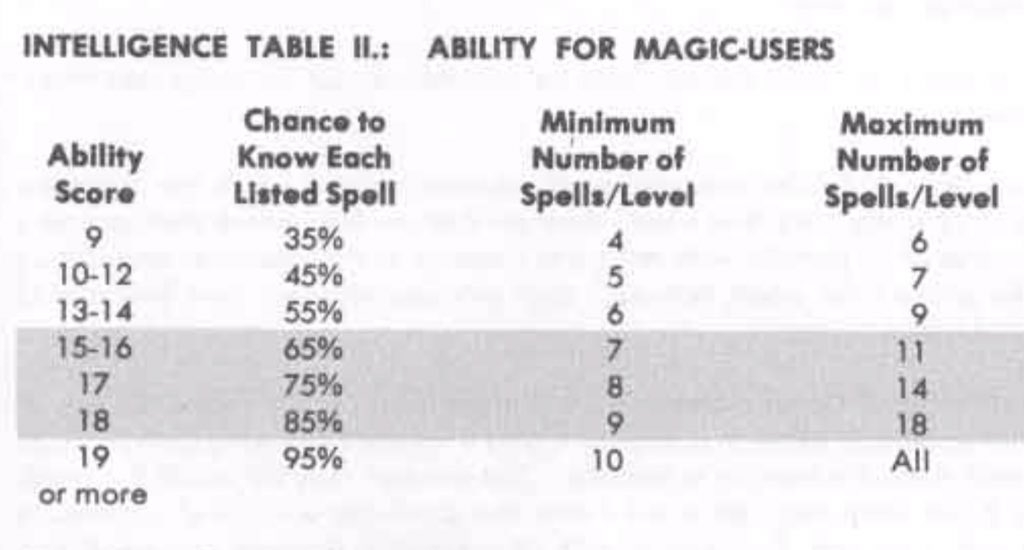
![1e assigns a failure chance and a chance of reverse/harmful effects when a MU casts a higher level spell this way. The chance of failure is 5% x [level needed to cast spell - current level] 1e assigns a failure chance and a chance of reverse/harmful effects when a MU casts a higher level spell this way. The chance of failure is 5% x [level needed to cast spell - current level]](https://pbs.twimg.com/media/D2bONZbX0AAiVqE.jpg)




